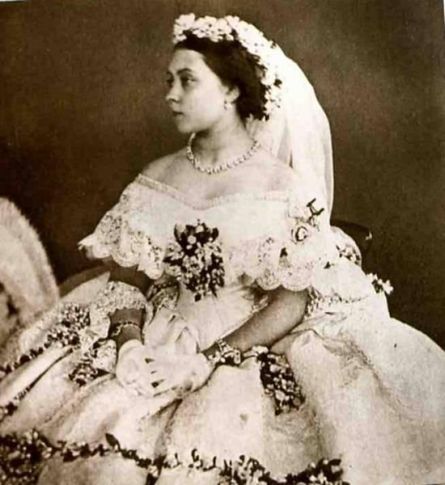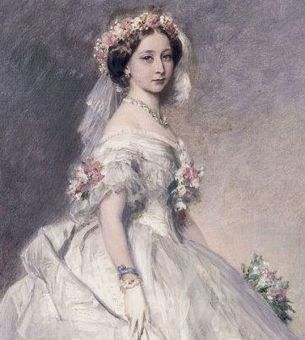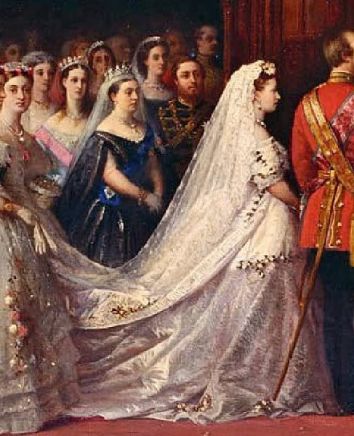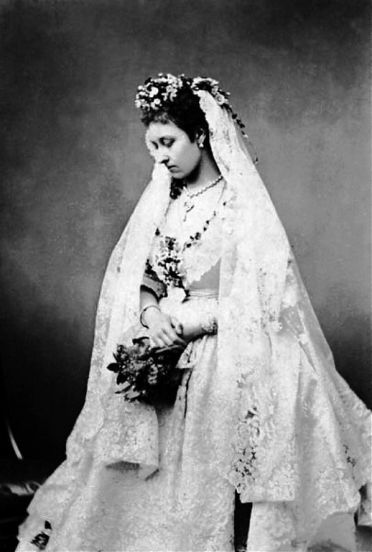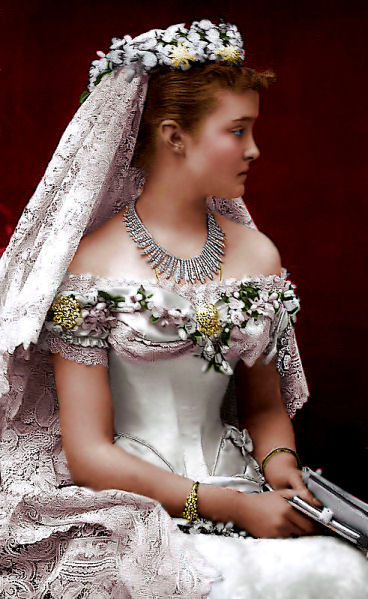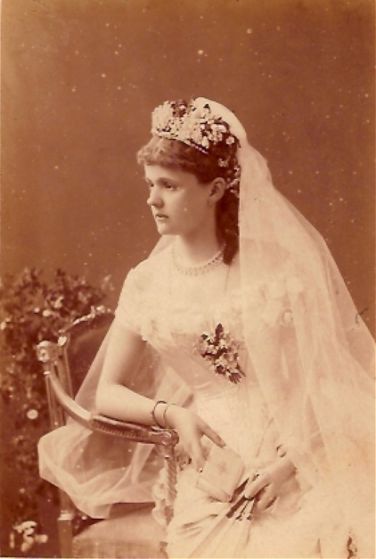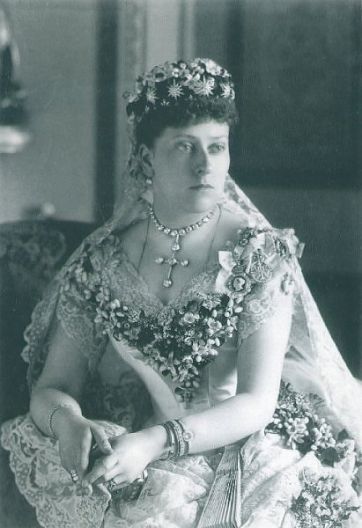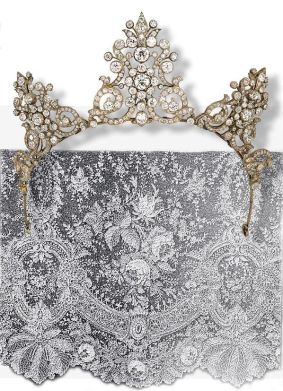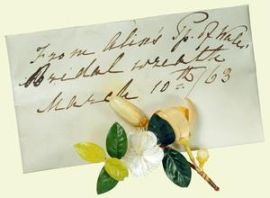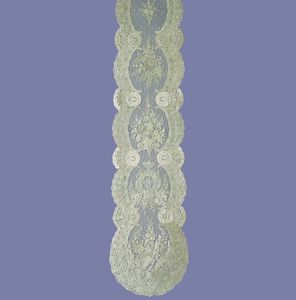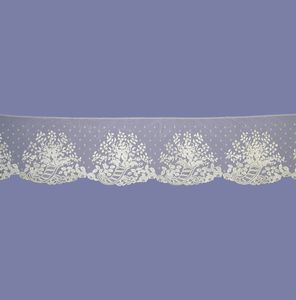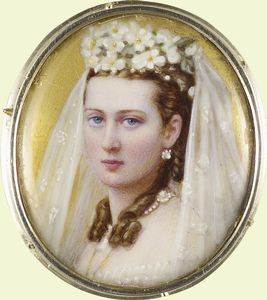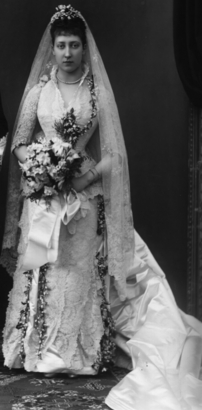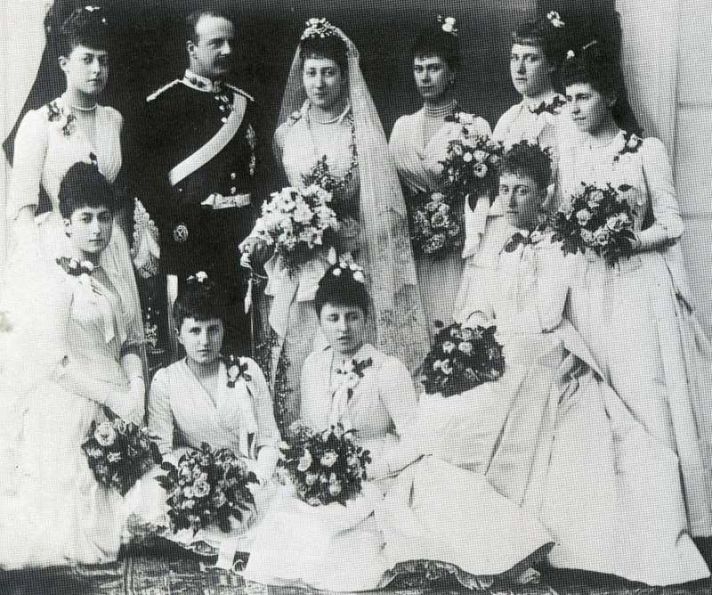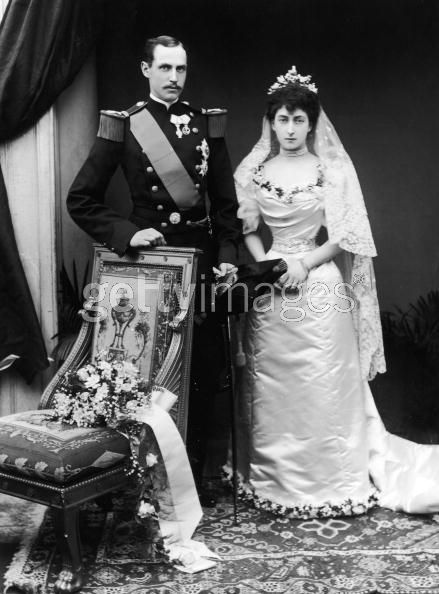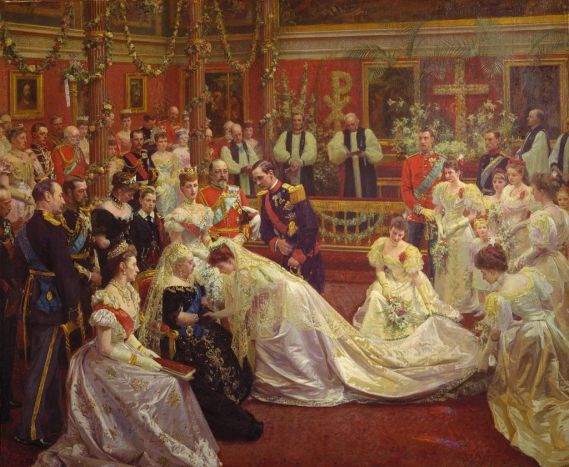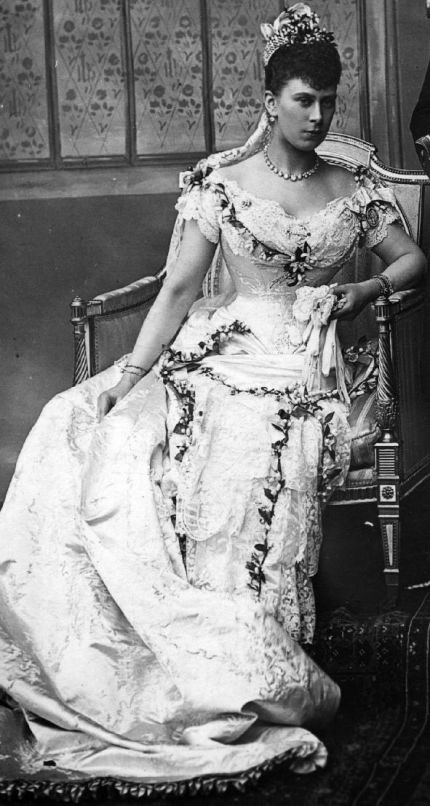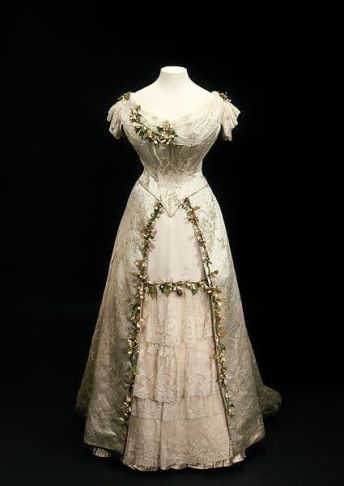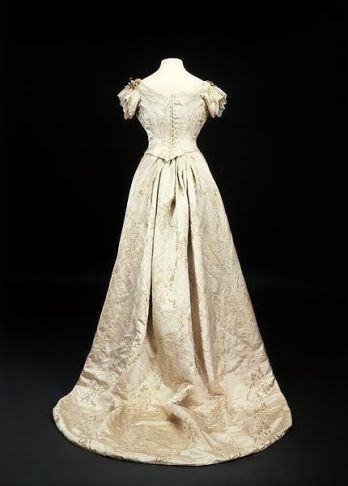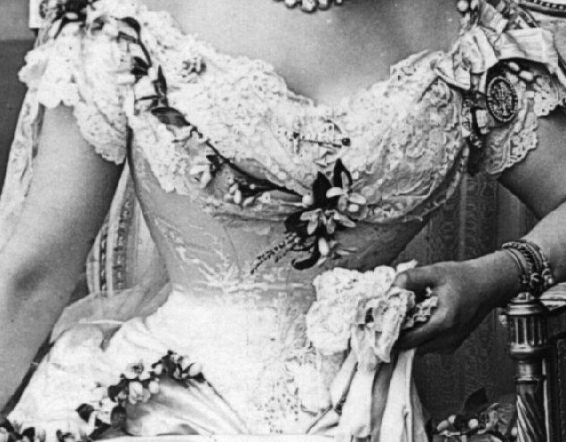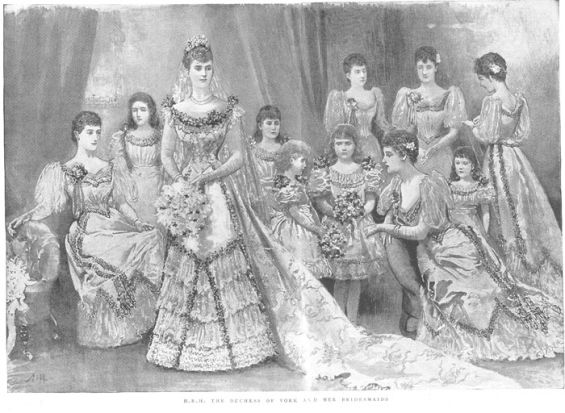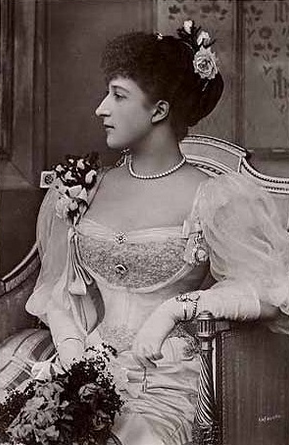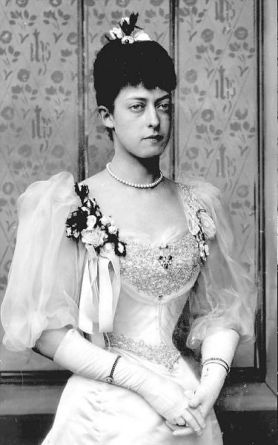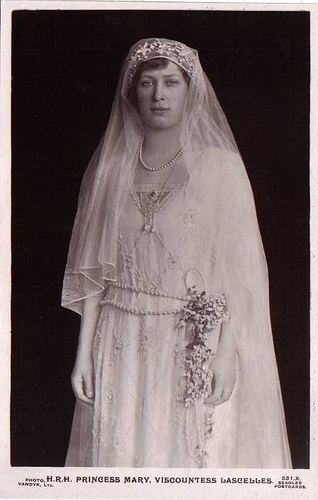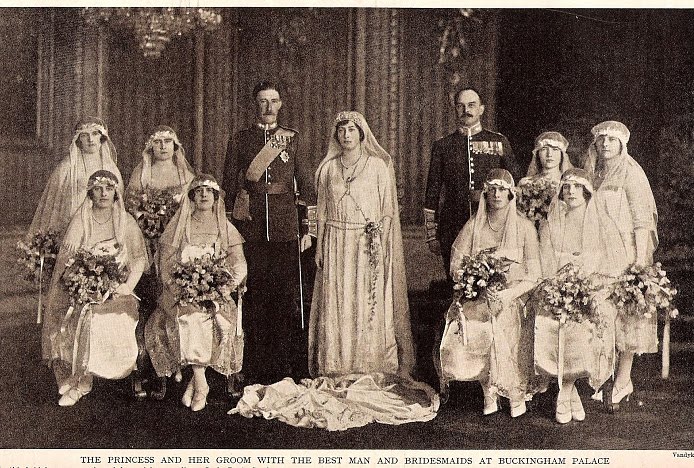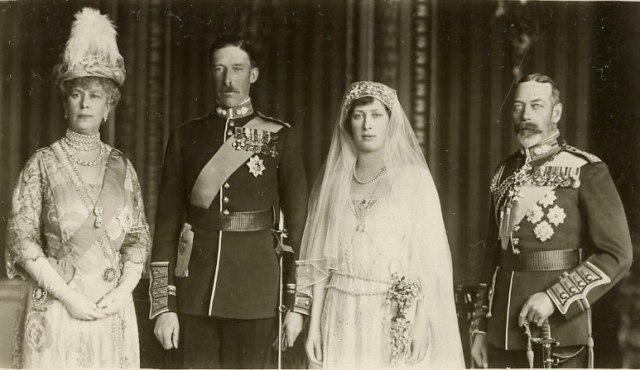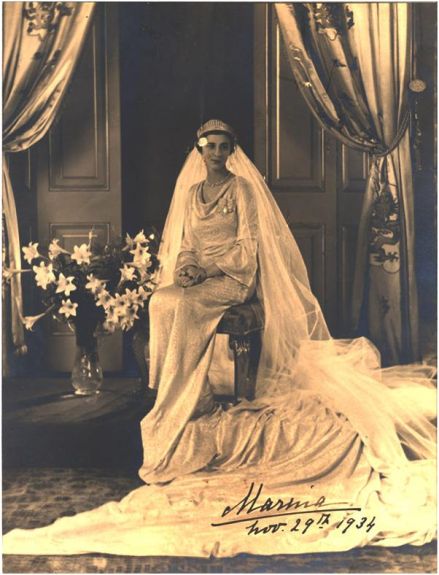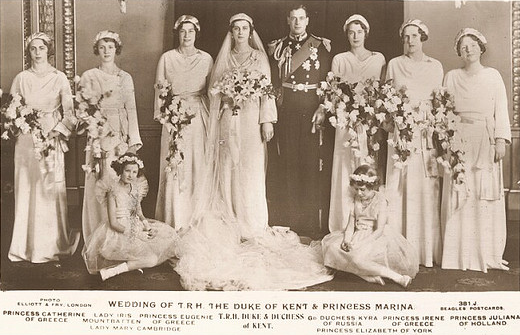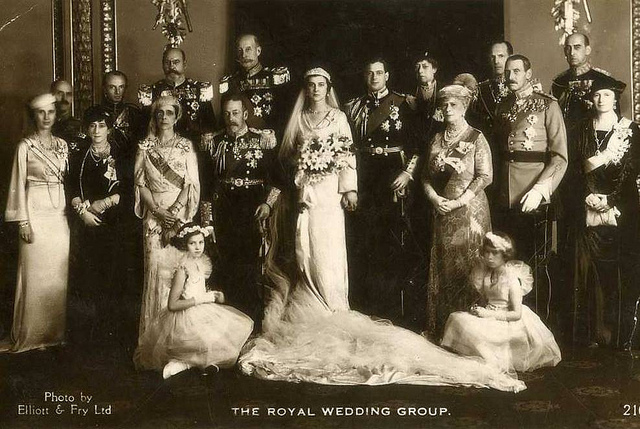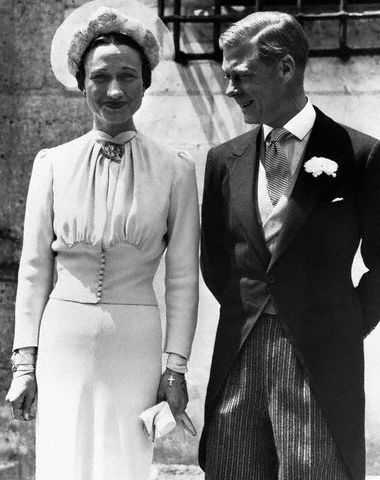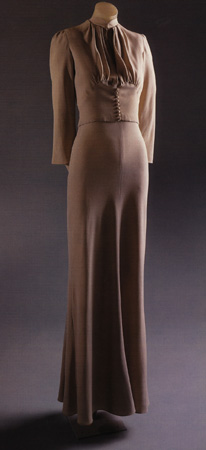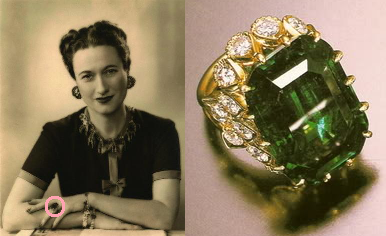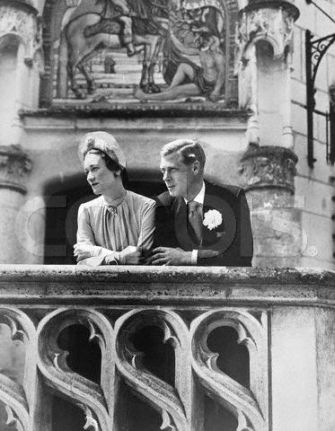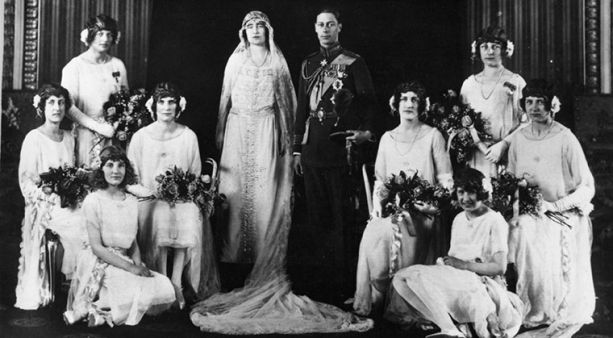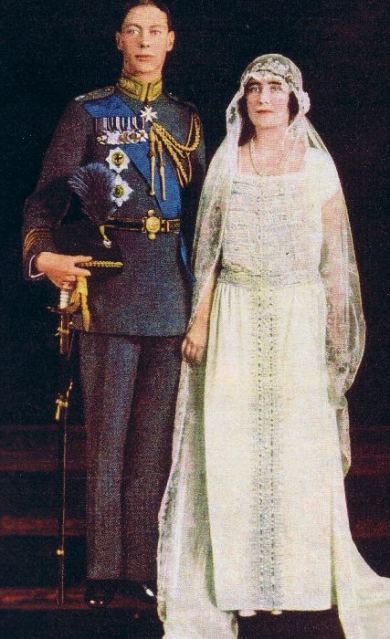Historical Royal Weddings
Jump to navigation
Jump to search
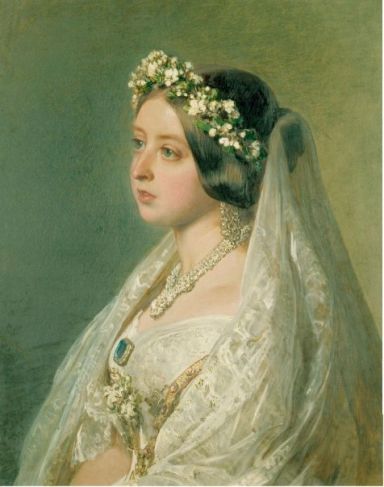 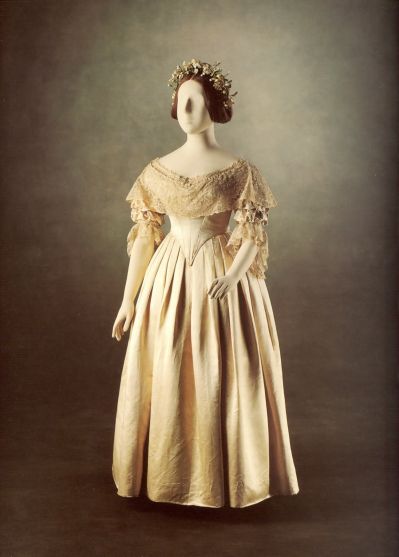 Queen Victoria decided against the traditional royal silver wedding dress and wore a dress of rich pure white satin, trimmed with orange flower blossoms. The lace which formed the flounce of the dress was Honiton lace; it measured four yards, and was three quarters of a yard wide. This touched the hearts of women everywhere regardless of their status in society and so began the tradition of the white wedding dress and the bride “a queen for a day”. The styles of the white wedding dress have changed throughout the years, but the concept has stayed the same. Queen Victoria & Prince Albert broke from tradition and started a tradition we still follow today.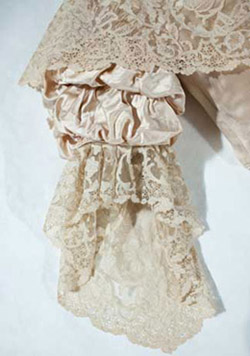 The pattern was a rich and exquisitely tasteful design, designed especially for Queen Victoria’s wedding dress. 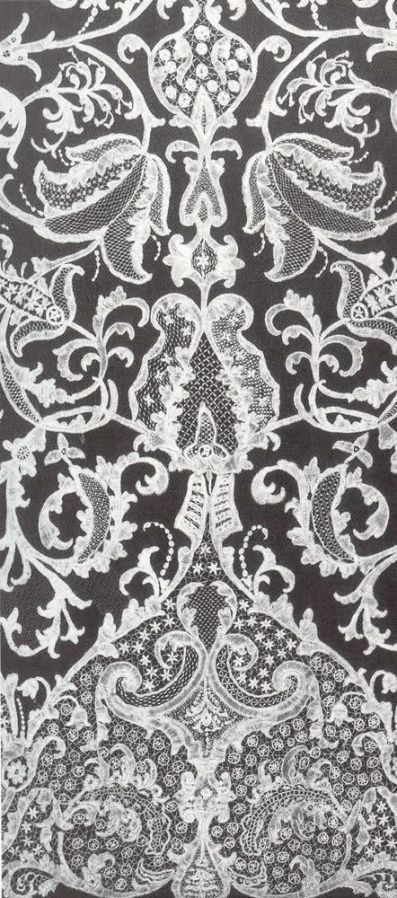 The headdress was a wreath of orange flower blossoms, and over this a beautiful veil of Honiton lace, worn down her back. Her slippers were white as well. The headdress was a wreath of orange flower blossoms, and over this a beautiful veil of Honiton lace, worn down her back. Her slippers were white as well. 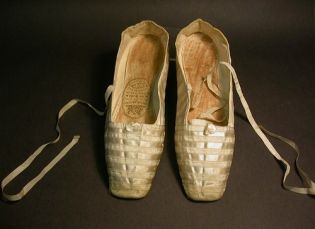 The bridesmaids or train-bearers, as they were called back then, were also dressed in white. Prince Albert did not wear the royal finery that was tradition at the time. Instead he wore a field marshal’s uniform, with large rosettes of white satin near his shoulders. In doing this, his bride stood out as the most important person in the chapel and gave to Queen Victoria her “hour of beauty”. 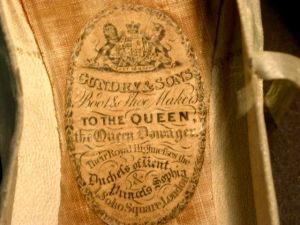 The Godey’s Lady’s Book, written about a decade after the 1840 royal wedding wrote: “Custom has decided, from the earliest ages, that white is the most fitting hue, whatever may be the material. It is an emblem of the purity and innocence of girlhood, and the unsullied heart she now yields to the chosen one.” The dress and her wedding attire is currently on display at the Victoria and Albert Museum. |
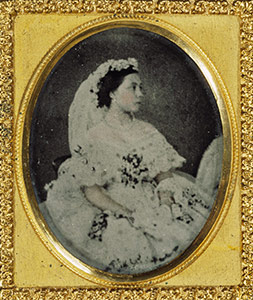 Princess Victoria, Princess Royal of the United Kingdom Princess Victoria, Princess Royal of the United KingdomEmpress of Germany (21 November 1840 - 5 August 1901) In 1858 a royal wedding took place that was designed to align the fortunes of Europe's two most important powers, Great Britain and Germany's chief principality, Prussia. The bride was Victoria, or “Vicky, Princess Royal ”the oldest child of England's longest serving queen, Queen Victoria, and her husband, Prince Albert. She married Prince Frederick of Prussia, later Frederick III, Emperor of Germany and King of Prussia, son of William I and Marie, Princess von Sachsen-Weimar-Eisenach, on 25 January 1858 at St. James's Palace, Chapel Royal, St. James's, London, England. As the couple left St. James Chapel, they were serenaded by Mendelssohn's “Wedding March,” the first time it ever was played at a wedding. For her wedding, Vicky wore a grown of white silk moiré over a petticoat flounced in lace and wreathed in sprays of orange blossom and myrtle. Her train was trimmed with white satin ribbons and lace. Her lace veil was held in place by a matching wreath, and she wore a diamond necklace, earrings, and brooch. From "Imperial Courts of France, England..." by Walter Bidwell: On this occasion the Princess Royal wore an exquisitely becoming beautiful and white dress. In fact its unity only recalls to mind the belle of the French Court who is said to dress with such a perfection of good taste that one can never observe what she wears. While however we mention this as the actual effect of the costume we may state for the further information of our readers that it was manufactured by Mrs Darvill designed by Miss Janet Fife and composed of a rich robe of white moire antique ornamented with three flounces of Honiton lace. The design of the lace consists of bouquets in open work of the rose, shamrock, and thistle in three medallions. At the top of each flounce in front of the dress are wreaths of orange and myrtle blossoms; the latter being the bridal flower of Germany, every wreath terminating with bouquets of the same flowers and the length of each being so graduated as to give the appearance of a robe denned by flowers. The apex of this floral pyramid is formed by a large bouquet worn on the girdle. The train which is of the unusual length of more than three yards is of white moire antique trimmed with two rows of Honiton lace surmounted by wreaths similar to those on the flounces of the dress with bouquets at short intervals. The Queen, who had chosen lilac silk moiré with a velvet train, wore the crown diamonds and a royal diadem of diamonds and pearls. Queen Victoria wore the George IV diadem as can be seen in the photo below. A "european thinking" - the marriage was primarily the brainchild of Prince Albert, who dreamed that the United Kingdom, an eventually united Germany, under Prussian leadership, together would guide Europe into a future of liberalism, progress and prosperity. For Prince Frederick, Vicky ordered an engagement ring set with emerald exactly like the one her mother had given her father. Vicky asked her fiancé to wear it in the same way, on his little finger. 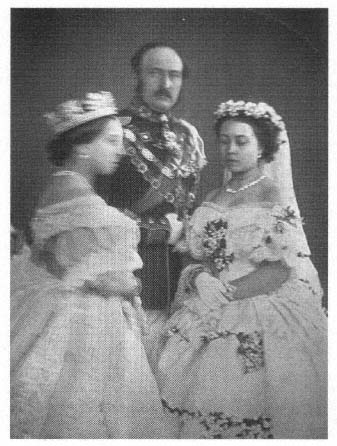 As for some of the gifts, Frederick had brought his bride a necklace of diamonds and turquoise, and his parents had presented her with a string of thirty-six “enormous” pearls, valued by the newspapers at 5.000. For Vicky there was also a diamond diadem from the King and Queen of Prussia; (“a lofty open coronet of diamonds, the design of which, with its thin spires of brilliants and open shell work between, probably one of the most chaste and graceful that has ever been executed.”) A dressing case in gold and coral came from her grandmother, the duchess of Kent; brussels lace from Uncle Leopold; a diamond “corsage” to be worn as a necklace or head ornament, along with three extra diamond clusters from the Queen; a bracelet and pendant in large emeralds and diamonds from her father; a “parure” of opals and diamonds from both her parents; and from each of her four sisters a brooch of the same pattern worked in different stones – diamonds, rubies, sapphires, and emeralds. Vicky and Frederick's many descendants include Sophia, Queen of Spain; Constantine II of Greece who descends from both his parents; Michael I of Romania; the last Queen consort of Yugoslavia, Alexandra of Greece and Denmark. |
Princess Alice of the United Kingdom, Grand Duchess of Hesse (25 April 1843 – 14 December 1878) Princess Alice was the second daughter of Queen Victoria and Prince Albert. On 1 July 1862, at Osborne House on the Isle of Wight, she married Prince Louis of Hesse and moved to Hesse, where she had several children including Alexandra, future Russian Empress and wife of Tsar Nicholas II. Some of her descendants include Prince Philip, Duke of Edinburgh and Lady Pamela Hicks, who was a bridesmaid at the wedding of Princess Elizabeth (later Queen Elizabeth II) and Prince Philip's wedding in 1947. From "The Royal Wedding Dresses" by Nigel Arch and Joanna Marschner (p.58): "She wore a 'half-high dress with a deep flounce of Honiton lace, a veil of the same and a wreath of orange blossom and myrtle'. It was a simple style and not embellished with a court train. Queen Victoria later confided to her daughter, the Princess Royal (Vicky), that the wedding of 'poor Alice' had been 'more like a funeral'." 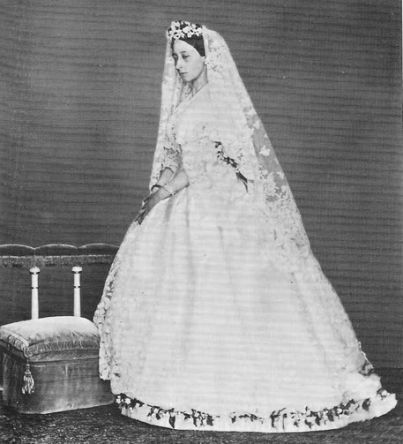 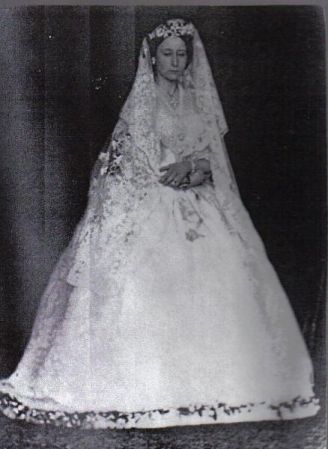 |
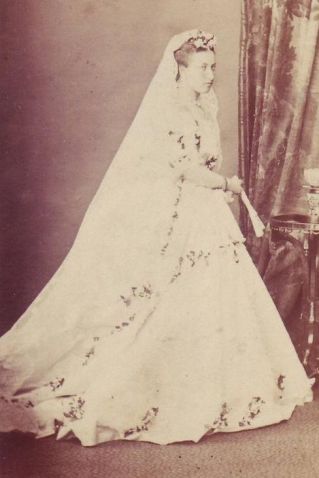 Princess Helena of the United Kingdom Princess Helena of the United KingdomPrincess Christian of Schleswig-Hostein (25 May 1846 - 9 June 1923) Princess Helena wore a bridal dress of rich white satin, with deep flounces of Honiton guipure, the train of extra length, trimmed with bouquets of orange blossom and myrtle, lined with white glace and trimmed with Honiton guipure, with cordons and bouquets of orange blossom and myrtle. The design of the lace was roses, ivy, and myrtle. The wreath was composed of orange blossoms and myrtle and the bridal veil (a square) was of the choicest Honiton lace, to match the dress. The Bride wore a necklace, earrings and brooch of opals and diamonds, the wedding gift of the Queen along with bracelets set with miniatures, and the Order of Victoria and Albert. The bridesmaids wore white tulle skirts, trimmed, with buillons of tulle over white glace slips, with tunics of silver tulle and chatelaines of flowers; forget-me-knots, blush roses and heather, with wreaths and veils to match. 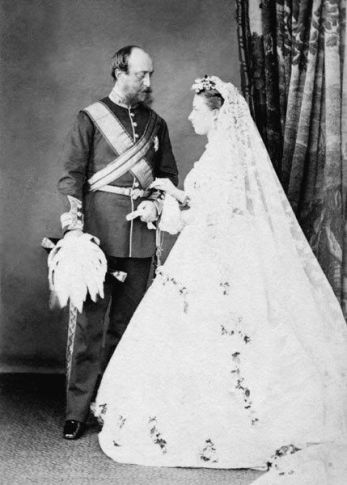 The Princess of Wales, formerly Princess Alexandra of Denmark, wore a dress of blue tulle over blue silk, richly trimmed with Irish lace riband and lillies of the valley; tiara of diamonds and veil; ornaments, pearls and diamonds. Princess Louis and Princess Beatrice wore a similar dress with petticoat of white tulle over white glace trimmed with a deep flounce of Irish point lace; train of blue satin trimmed with Irish point and silver gimp and balls of blue and silver; blush roses as head dress with feathers and veil; ornaments with diamonds. Her Majesty wore a rich black moire antique dress interwoven with silver and trimmed with black crape and a row of diamonds round the body. The Queen wore a coronet of diamonds attached to a long white crape lace veil, a diamond necklace and cross and a brooch composed of a large sapphire set in diamonds. She became the first of her family to celebrate her50th wedding anniversary in 1916, but her husband died a year later. Helena outlived him by six years, and died aged 77 at Schomberg House on 19 June 1923.Sadly, Helena's children did not produce heirs. Her only child to produce children was Prince Albert, but they were illegitimate. |
| Princess Louise was the fourth daughter and sixth child of Queen Victoria and Prince Albert. She married John Campbell, 9th Duke of Argyll, son of George Douglas Campbell, 8th Duke of Argyll and Lady Elizabeth Georgiana Sutherland-Leveson-Gower, on 21 March 1871. Louise's marriage to a peer was considered below her status and had not been done since the official marriage of Princess Mary Rose Tudor [[[Princess Margaret Tudor]] in the series] to Charles Brandon, 1st Duke of Suffolk on 13 May 1515. Louise wore a white satin wedding gown, heavily decorated with national and royal symbols, with deep flounces of flower-strewn Honiton lace. Her beautiful lace veil was held in place by two diamond daisy hair pins presented by Princes Arthur and Leopold and Princess Beatrice. They were supplied by Garrard. The daisy brooches are now the property of HRH Princess Michael of Kent whose husband received them as a legacy from his mother HRH Princess Marina, who may have received them from Princess Louise as a gift. The bracelet was a present of the Marquis of Lorne. The centre could be worn as a beautiful pendant ornament, with a large and fine sapphire mounted with brilliants and pearls and pearl drop; Princess Louise wore this pendant on a diamond necklace on her wedding day as clearly seen in the wedding picture. It was also supplied by Garrard. source:The Times; The Graphic; The Illustrated London News 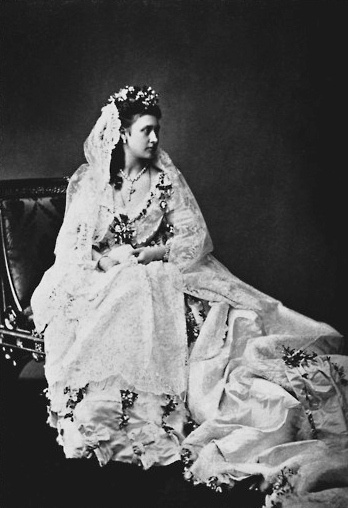 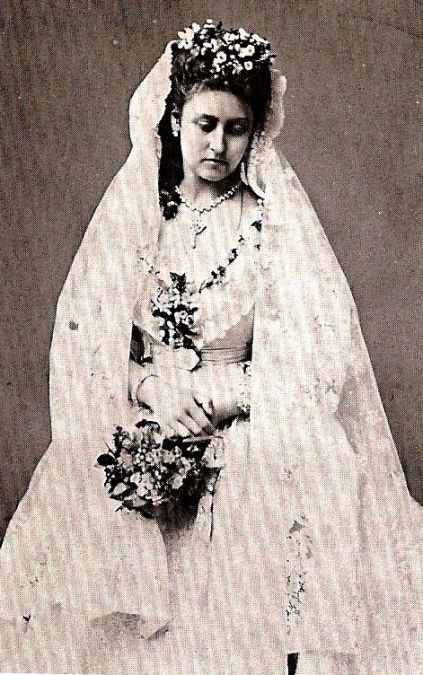 Wedding gifts included a tiara formed of a band of emeralds and diamonds, surmounted by a scroll work also of emeralds and diamonds which was given by the Duke and Duchess of Argyll. A locket with an large emerald, was a present of the Queen to her daughter, as well as a very large fine large emerald set with brilliants as a centre of a bracelet, now the emerald is in possession of HRH Princess Michael of Kent. Wedding gifts included a tiara formed of a band of emeralds and diamonds, surmounted by a scroll work also of emeralds and diamonds which was given by the Duke and Duchess of Argyll. A locket with an large emerald, was a present of the Queen to her daughter, as well as a very large fine large emerald set with brilliants as a centre of a bracelet, now the emerald is in possession of HRH Princess Michael of Kent.Pearl necklace and earrings—gift of the tenants of Balmoral and the Scotch servants of the Royal Household. The necklace “…is composed of twenty-eight fine Scotch pearls, well matched with fine lustre and orient, connected by lozenge-shaped links of gold. The pendant, designed from the antique, contains four very large Scotch pearls in a chased scroll-work of gold, ending with a fine pear-shaped pearl. The earrings are formed of two large pearls, set with four brilliants in a quatrefoil, separated by a blue enamel line from the gold border studded with small diamonds. A diamond ornament at the top and a pendant of three diamonds completes the design, which, as well as the workmanship, is supplied by Messrs. Sanderson and Son, Princes Street, Edinburgh.” Source: The Times, 16 March 1871; The Graphic 25 Mar 1871 A very handsome gold bracelet, with rubies and diamonds, was presented by the bridesmaids to Princess Louise. The marriage was a love-match and very happy, for forty-three years, but childless. Louise was a widow for twenty-five years before she died in the age of ninety-one, at Kensington Palace on 3rd December 1939. After her death, her wedding veil was placed about her face, which was still beautiful in old age and after she was cremated as she had desired, her wedding and engagement rings were put into her coffin with her ashes. |
| Princess Louise Margaret of Prussia Duchess of Connaught and Strathearn (25 June 1860 - 14 March 1917) Her father was Prince Friedrich Karl of Prussia, the son of Karl of Prussia and his wife Princess Marie of Saxe-Weimar-Eisenach. Her mother was Princess Maria Anna of Anhalt, daughter of Leopold IV of Anhalt-Dessau. She married the third son and seventh child of Queen Victoria and Prince Albert; Prince Arthur Albert, 1st Duke of Connaught and Strathearn on 13 March 1879. Princess Louise Margaret of Prussia, the bride, wore a heavy white satin dress, a band of lace ten centimetres long encircling the waist. The skirt was sewn with lace 30 centimetres wide and decorated with a bunch of myrtle-leaves, the emblem in Germany of the bridal state. The train was four metres long and surmounted by a lace flounce one metre in width made in Silesia, in which a sprig of myrtle was fixed. The bridal veil was about three metres square, made of point d'Alencon lace, the design representing orange blossoms, roses, and myrtle-leaves intertwined. And was fastened to her hair with five diamond stars, the gift of the bridegroom. Above in her wedding photograph, the stars are clearly visible in front of her floral wreath. The handkerchief was made of the same material as the veil and showed the same design, one corner being embellished with the princess's monogram the other with a Prussian eagle. The Princess had a beautiful bridal bouquet of white flowers in her hand. 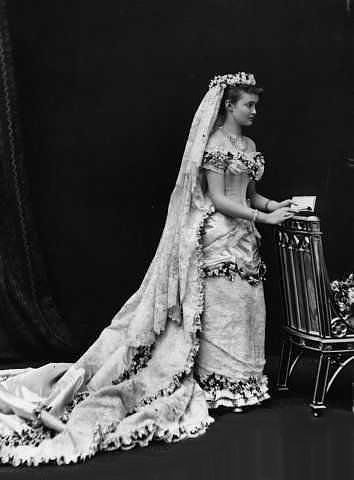 The bridesmaids wore dresses of the richest white satin duchess faille and mousseline de soie, embroidered with wild rosebuds and foligae, flowers representing England, Scotland, Ireland and Germany. Also visible in the picture of the bride, are the diamond fringe necklace formerly the property of the Duchess of Kent the gift of the Queen, the diamond brooch which was the gift of the Queen on her right shoulder, the diamond and pearl brooch with diamond and pearl pendant (the gift of her father Prince Frederick Charles) was worn in the centre of the neckline, a gold and diamond bracelet which was the gift of the groom's brothers and sisters. As well as the wedding present of the Town of Windsor, which presented the Princess with a diamond bracelet having a rosette centre, and valued at about £280. The words "From Windsor" are engraved upon the gold armlet, and the case bears the inscription "From Windsor to Her Royal Highness the Princess Louise Margaret Alexandra Victoria Agnes of Prussia on her Marriage, march 13th, 1879." The Queen's gift consisted of a magnificent diamond tiara, a pearl and diamond penchant, among other items. Many members of England and Germany's royal families attended, such as the Prince and Princess of Wales. Their descendants include Carl XVI of Sweden, father of Crown Princess Victoria; Queen Margrethe II of Denmark; and the former Queen Anne-Marie of Greece. |
Princess Helena married Prince Leopold, Duke of Albany, the youngest son of Queen Victoria and Prince Albert. Princess Helena was the daughter of George Victor, Prince of Waldeck and Pyrmont and his wife Princess Helena of Nassau. On 27 April 1882, Leopold and Helena married in St. George's Chapel, Windsor Castle. After their wedding, Leopold and Helena resided at Claremont House. 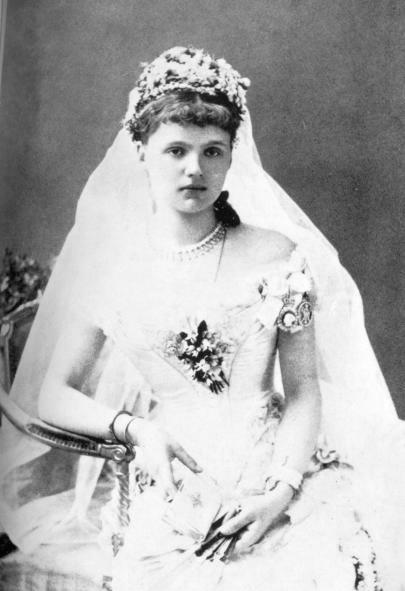 The Duchess’ gown harkened back to an earlier age and was nothing if not sumptuous and in good taste. She wore a crown of jewels and flowers supporting her long tulle bridal veil, her shoulders were bare and her short sleeves were adorned with jeweled symbols of Royal orders. Her bosom was swathed in tulle and ruched laces and was set off by a small bouquet of flowers. Her waist was tucked in neatly with a corset and her bodice was sharply V–ed to accentuate her good figure. Her skirt was ruched and trimmed. She was the ideal young bride. Every young woman wanted to be like her. And according to period photographs, on their wedding day many brides were able to achieve a similar affect. The bride's wedding dress which had been presented by her sister, Queen consort Emma, consisted of a petticoat of rich white satin showing at the edge orange blossoms and myrtle, trimmed with point d'Alencon lace. The long train was embroidered in silver and raised bouquets of fleur-de-lis edged with white satin and point d'Alencon. The veil was of the same fabric and the wreath was of orange flowers and myrtle. [Source: Our Queen; the life and times of Victoria] When Princess Helene of Waldeck-Pyrmont married Prince Leopold, Duke of Albany, she received large diamond sprays from the King & Queen of the Netherlands, her sister. She wore it as tiara and brooch on her wedding day. She also received a diamond necklace (in pictures) and sun rays which she wore as brooches from her parents. Prince Leopold, her fiancée, gave Helena a necklace of diamonds, a large diamond star, a ruby bracelet, a ruby and diamond bracelet, sapphire and diamond earrings, Spanish lace, and a fan. Gifts from Queen Victoria included a pearl and diamond necklace, an amethyst and diamond necklace, a parure of coral cameos, old enamel and diamond brooch and earrings. The couple had a brief, but happy marriage, ending in the hemophiliac Leopold's death from a fall in Cannes, France, in March 1884. After the death of Alfred, Hereditary Prince of Saxe-Coburg and Gotha in 1900, Helena's sixteen-year-old son, Prince Charles Edward, was selected as the new heir to the German Duchy. When the First World War broke out 14 years later, Charles Edward found himself fighting in the German Army. As a result, he was stripped of his British titles by an act of Parliament in 1917. Her daughter Princess Alice remained in England and married Prince Alexander of Teck, 1st Earl of Athlone which made her the sister-in-law of George V's consort, Queen Mary. Prince Charles Edward, Duke of Saxe-Coburg-Gotha's daughter Princess Sybilla would go on to marry the son of King Gustav VI of Sweden, Prince Gustaf Adolf, Duke of Västerbotten. Prince Gustaf was her second cousin; he was the grandson of Prince Arthur, Duke of Connaught and Strathearn. The couple were parents to the current King of Sweden. |
Princess Beatrice was the last child and girl of Queen Victoria and Prince Albert. On 23 July 1885, Beatrice married Prince Henry of Battenberg, son of Prince Alexander of Hesse and by Rhine and Julia Therese née Countess of Hauke. The wedding that took place at Whippingham Church on the Isle of Wight. The church has a display which features a mock-up of the original wedding dress and photos from the actual wedding. It was the greatest royal occasion that the Island ever witnessed. 200 guests from London including ambassadors and politicians were brought by special train to take their seats at the church. On the day of the wedding, a procession of fourteen carriages left Osborne House. The royal route was decorated with flags hung on masts, triumphal arches and stands for the crowds to get a view. A boarded foot way and canopy led from the churchyard gate to the church door, with additional seating built outside. Inside the church the floor had been covered in crimson cloth and oriental rugs. The Illustrated London News reported “exquisite flowers were everywhere”. Just eight Islanders made it into the church for this state occasion. In place of the vicar were the Lord Chamberlain, the Archbishop of Canterbury, the Bishop of Winchester and the Dean of Windsor. In place of the local choir was the choir of St George’s Chapel, Windsor. 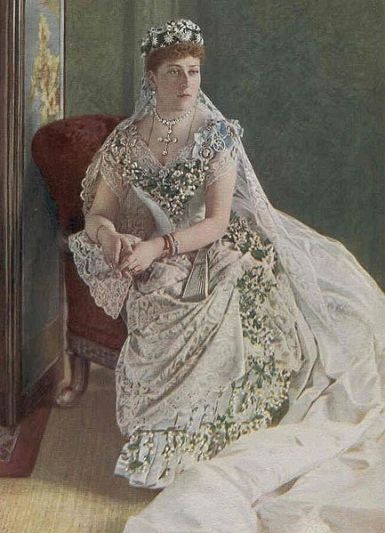 Prince Henry, wearing the white uniform of a captain of the Prussian Cuirassiers, arrived at East Cowes to a roar of cannon and an ecstatic public welcome. Princess Beatrice advanced along the aisle accompanied by ten royal bridesmaids, her nieces: Princesses Louise, Victoria and Maud of Wales, Alexandra of Hesse; Marie, Victoria Melita, and Alexandra of Edinburgh, Helena Victoria and Marie Louise of Schleswig-Holstein and Princess Alice of Albany who were dressed in ivory gowns. Beatrice wore a beautiful dress of white satin trimmed with the Honiton lace of her mother, which none of her other siblings had been permitted to wear, decorated with orange blossom, myrtle and heather. She was also the only sibling allowed to wear her mother's wedding veil which was emblazoned with a diamond circlet with diamond stars, a marriage gift from her mother. She also wore diamond collet drop earrings, a diamond collet necklace with a very large diamond cross suspended from it, a diamond bee brooch (picture left and above on the bodice), a diamond rose brooch, and a large diamond butterfly brooch on her right shoulder. On her right wrist, a wide diamond and sapphire bracelet (the gift of the groom), and on her left wrist an assortment of bangles - five in total, some with diamonds and others plain gold. The orders worn were those of Victoria and Albert, Crown of India, Gold Lion of Hesse, Royal Red Cross and the Saxe-Coburg and Gotha family order. Beatrice held a white fan and wore elbow-length white gloves in her pictures. The newspapers and Beatrice's mother, Queen Victoria, wrote these details in her journal entry of 23 July 1885 about the jewels of the bride. 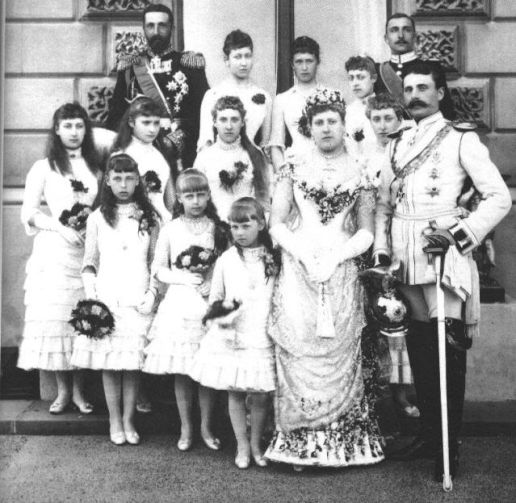 The royal family took their seats to the sound of Handel’s March from the Occasional Overture. Then, at 1pm, the Wedding March sounded and Princess Beatrice advanced along the aisle escorted by her mother, Queen Victoria, and her eldest brother, the Prince of Wales (Edward VII). With the service complete the wedding party returned to Osborne through the cheering crowds. Two large boarded reception marquees had been built either side of the palace. One was reserved for the guests of “royal blood” and the other was for the rest. Back at the church there was no such decorum. The excited crowds rushed in to seize any mementos of the great occasion. Beatrice and Henry settled to happy married life at Osborne. Over the next five years she gave birth to Alexander, Victoria Eugenie, Leopold and Maurice. Source: The Scotsman; Illustrated London News;Bury; Graphics; 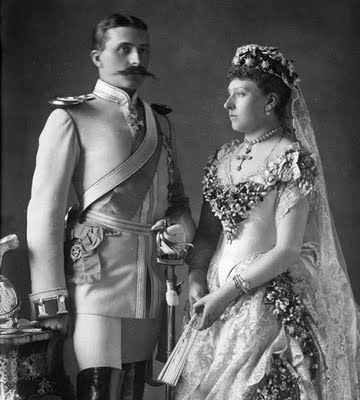 Beatrice was given the Strawberry tiara and parure as a present from her mother, Queen Victoria, on her marriage to Prince Henry of Battenberg on 23 July 1885. The tiara of strawberry leaves that was once set with rubies, was a favorite jewel of Queen Victoria. Princess Beatrice of Battenberg made it larger and higher by mirroring the design in a gallery of diamonds below. From Beatrice, it passed to her son the Marquess of Carisbrooke. The Queen also gave lace to Princess Beatrice along with The Victorian diamond set tiara. With stylised fleur-de-lys and scroll motifs graduating from the centre it was set with old round brilliant-cut and rose-cut diamonds. The total estimated weight was 30cts; all mounted in silver grain and cut-down settings on yellow gold back. The tiara was convertible into a necklace circa 1870. the tiara was sold in 2000 for £42500. The bride received from her parents-in-law, Prince Alexander of Hesse and the Princess of Battenberg, a diadem with sapphire cabochons and diamonds. The gift of the bridegroom was the shell pendant with sapphires and diamonds, a bracelet and a pair of earrings. His brother Prince Alexander of Bulgaria presented the large brooch with sapphires and diamonds. 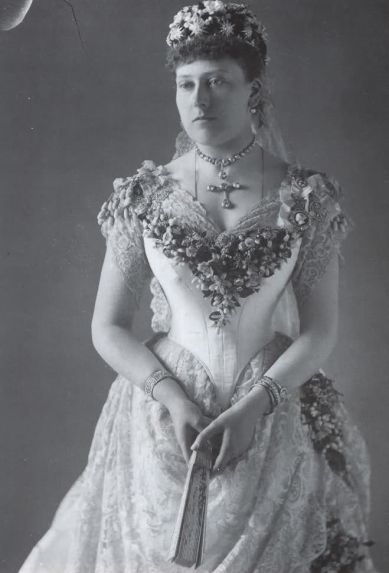 An Indian turquoise and pearl necklace was the wedding present from her younger brother and his wife, the Duke and Duchess of Connaught. An Indian turquoise and pearl necklace was the wedding present from her younger brother and his wife, the Duke and Duchess of Connaught.Interesting fact: Princess Beatrice was, before her marriage, the possessor of a great deal of rare and beautiful dentelles and among other treasures the magnificent lace that Queen Katharine of Aragon brought with her when she first came to England as a bride. |
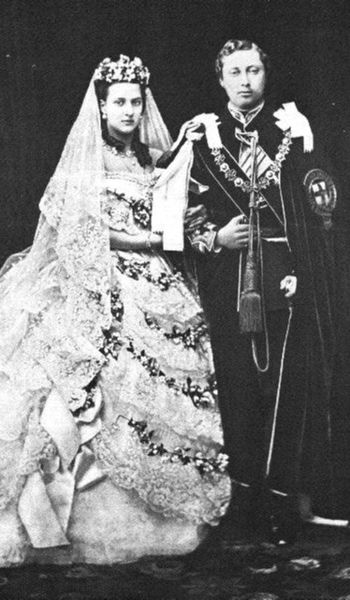 Princess Alexandra of Denmark Princess Alexandra of DenmarkQueen consort of the United Kingdom (1 December 1844 – 20 November 1925) She was the daughter of Christian IX of Denmark and Princess Louise of Hesse-Cassel; both descendants of King George II of Great Britain. Princess Alexandra married Albert Edward, the Prince of Wales, eldest son and heir of Queen Victoria and Prince Albert. They were married on 10 March 1863 at St. George's Chapel, Windsor Castle by Thomas Longley, the Archbishop of Canterbury. The choice of venue was criticized in the press (as it was outside London large public crowds would not be able to view the spectacle), by prospective guests (it was awkward to get to and, as the venue was small, some people who had expected invitations were not invited) and the Danes (as only Alexandra's closest relations were invited). The court was still in mourning for Prince Albert, so ladies were restricted to wearing grey, lilac or mauve. Alexandra's wedding dress was described as "symbolic, echoing long traditions of wedding attire and a fashionable court dress of completely english manufacture." Eighteen-year-old Princess Alexandra wore a gown draped in Honiton lace and garlands of orange blossoms. Her silver moire train was so long it had to carried by eight bridesmaids. The bouquet was composed of orange blossoms, white rosebuds, lilies of the valley, and rare and beautiful orchideous flowers, interspersed with sprigs of myrtle. 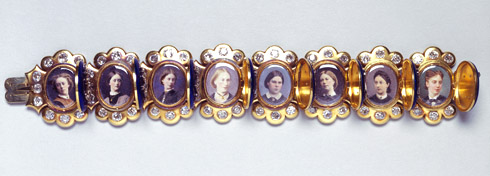 [The Royal Collection © 2008, Her Majesty Queen Elizabeth II] Princess Alexandra's bridesmaids were all daughters of Peers of the Realm; from left to right: Ladies Diana Beauclerk, Victoria Scott, Georgina Hamilton, Victoria Howard, Elma Bruce, Agneta Yorke, Eleanor Hare and Feodore Wellesley. 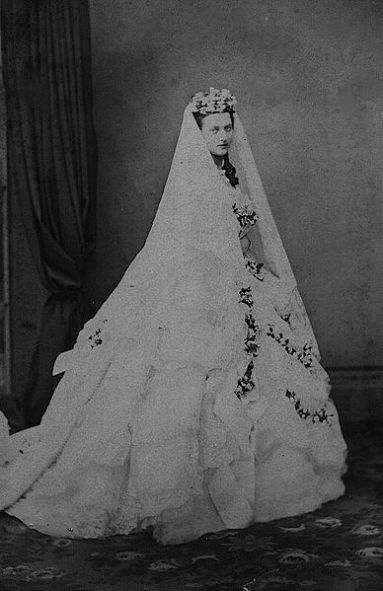 The bouquet was supplied by Mr. J Veitch. The lace for the wedding dress of H.R.H the Princess Alexandra was of Honiton manufacture, and was designed and executed by Messrs. John Tucker and Co. of Branscombe, near Sidmouth. It was composed of four deep flounces of exquisite fineness, nearly covering the dress, with lace for train, veil and pocket handerkerchief en suite. The design (made by Miss Tucker) was a sequence of cornucopia, filled with rose, shamrock and thistle, arranged in festoons, and interspersed with the same national floral emblems. The bouquet was supplied by Mr. J Veitch. The lace for the wedding dress of H.R.H the Princess Alexandra was of Honiton manufacture, and was designed and executed by Messrs. John Tucker and Co. of Branscombe, near Sidmouth. It was composed of four deep flounces of exquisite fineness, nearly covering the dress, with lace for train, veil and pocket handerkerchief en suite. The design (made by Miss Tucker) was a sequence of cornucopia, filled with rose, shamrock and thistle, arranged in festoons, and interspersed with the same national floral emblems. The wedding ring cost £2.2s and a ‘Gold guard do (ditto) w[ith] Stones [spelling] “Bertie”’ at £14 is said to be one of the first presents the Prince of Wales gave to Princess Alexandra. The ring spelt "Bertie" with the initial letters of each stone: Beryl, Emerald, Ruby, Turquoise, Jacinth, Emerald. A keeper was also ordered for her wedding ring. The jewels were supplied by Garrard. On the occasion of her wedding Princess Alexandra was given a diamond tiara, now known as the "Rundell" by her groom, Edward the Prince of Wales. It was of stylized trefoils and lovers’ knots and wearable in different versions, also together with stars on top, see picture above on left, the scrolls were interchangeable. Princess Alexandra, who came from a small country, lacked jewels, so when she married in 1863, he gave her this monumental parure of diamonds, diamond tiara/coronet with matching necklace, brooch and earrings with pearls and diamonds. The Princess wore it on her wedding day. 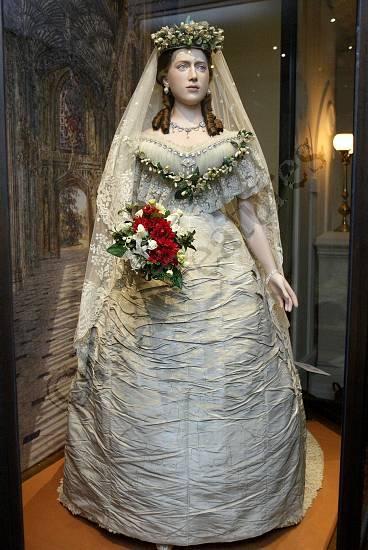 Among her many gifts was the Dagmar necklace. It was the wedding gift to Princess Alexandra from the Danish King, her mother's cousin, King Frederik VII. It may well be the most splendid Danish wedding present ever given to a Danish princess and reportedly cost £7,000 at the time of its manufacture. On the occasion of her marriage, Princess Alexandra was given by the Ladies of North Wales a large emerald and diamond oval brooch with an emerald and diamond leek in the centre and cabochon emerald drop, along with matching earrings. A pendant from the Ladies of South Wales was also given to Alexandra. 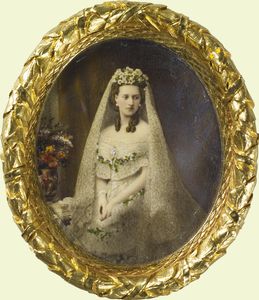 The Princess received two beautiful diamond and sapphire pendants. The pendant of diamonds with five sapphires set in the form of a cross with a pendant pearl suspended was presented by TRH Prince Alfred, Princess Helena, Princess Louise, Prince Arthur, Prince Leopold and Princess Beatrice (Edward, Princes of Wales' siblings). It was made by Garrard and Co. The Princess received two beautiful diamond and sapphire pendants. The pendant of diamonds with five sapphires set in the form of a cross with a pendant pearl suspended was presented by TRH Prince Alfred, Princess Helena, Princess Louise, Prince Arthur, Prince Leopold and Princess Beatrice (Edward, Princes of Wales' siblings). It was made by Garrard and Co.A diamond rivière and earrings with pear-shaped diamond pendants were the gift of the Corporation of the City of London; made by Garrard. The Princess wore the necklace on the day of her wedding. The Cambridge bracelet was a wedding present to Princess Alexandra from the Duke of Cambridge, Queen Victoria’s first cousin. The three diamond ostrich feathers in the centre are the heraldic badge of the Prince of Wales. The enamel clasp on the bracelet dated from early in the reign of King William IV, the Duke’s uncle. 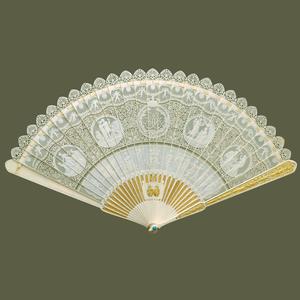 [The Royal Collection © 2008, Her Majesty Queen Elizabeth II] A turquoise and brilliant-set bracelet with the cypher “L. A.” surmounted by a crown set in diamonds on rock crystal which was made by Wondra, Darmstadt and was the gift of the Prince and Princess Louis, Grand Duke of Hesse. A gold buckle bracelet, which has a clasp of enamel and diamonds, was presented by HRH Princess Mary of Cambridge. Sources :The Illustrated London News, 21 March 1863. The Times 15 Apr 1863; The Times 18 Mar 1863; Russell, W.H. A Memorial of the Marriage of HRH Albert Edward Prince of Wales and HRH Alexandra Princess of Denmark. This finely carved fan, seen right, was a wedding present to Princess Alexandra of Denmark from a group of Danish ladies, on her marriage to the Prince of Wales in 1863. The decoration includes two conjoined A's, the first initials of both the bride and the groom, Alexandra and Albert Edward. Appropriately the pin of the fan is set with turquoise, the birthstone for December, the month of Princess Alexandra’s birth, as well as being symbolic of true love. [The Royal Collection © 2008, Her Majesty Queen Elizabeth II] |
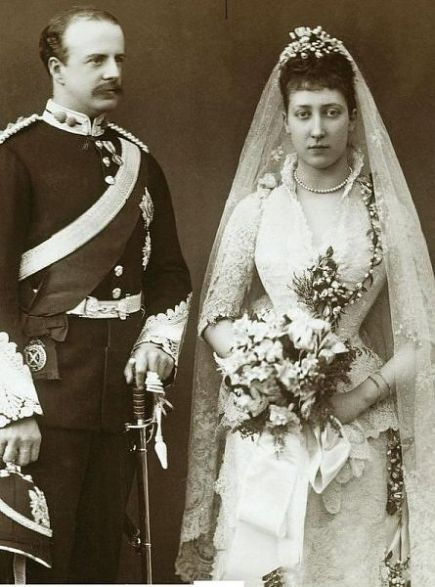 Princess Louise, Princess Royal of the United Kingdom Princess Louise, Princess Royal of the United KingdomDuchess of Fife (20 February 1867 – 4 January 1931) Princess Louise, Princess Royal married her third cousin, Alexander Duff, the 6th Earl of Fife on Saturday, July 27, 1889 in the private chapel at Buckingham Palace. 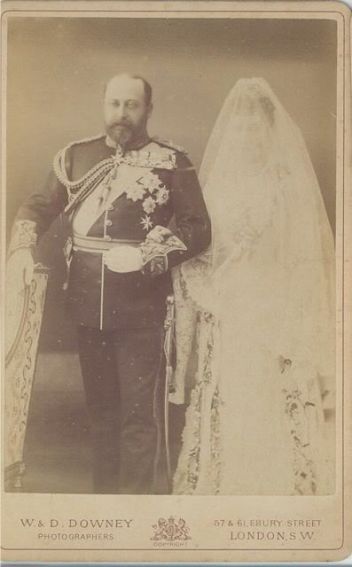 Two days after the wedding, Queen Victoria created Duff Duke of Fife and Marquess of Macduff. Two days after the wedding, Queen Victoria created Duff Duke of Fife and Marquess of Macduff.The dress was white. The neckline was v-neck with ruffles around the neck, a modern version of a Tudor neckline. Lace was applied to the dress; sleeves and the front of the gown. Louise's veil was knee length topped with beautiful flowers. A miniature fan of sapphires and rubies were worn in hair. Upon her dress were rows of flowers which hung down her gown; much like her mother's (Queen Alexandra) dress. A long silk train completed the look. The bridesmaids dresses were pale pink and Louise is said to not only have a hand in designing them but her own wedding dress. The Prince of Wales gave Lord Fife a fine silver model of a stag and hounds while the Princess presented him with a portrait of his bride set in pearls. Princess Louise was the first child and daughter of the Prince and Princess of Wales (King Edward VII and Alexandra of Denmark) to marry, and might thus have received more (and perhaps more expensive) gifts. From her fiancé gifts included the ruby and diamond engagement ring; and a diamond collet necklace “which could hardly be surpassed in regard to the size and purity of the stones". The Duke also gave the Princess a small diamond tiara. It was also from the Duke that Louise received the famous "Fife tiara" which is known as the Massin tiara; which is featured on the more British royal tiaras. The wedding party: to the bride's immediate right is May of Teck, who would be engaged to her oldest brother, Prince Albert in 1891. In 1892, Albert died suddenly of pneumonia; Mary would then become engaged and later marry the future George V in 1893. The the left of the groom is Louise's sisters Princess' Victoria and Maud. The other bridesmaids were Princesses Helena Victoria and Marie Louise of Schleswig-Holstein and Princesses Victoria, Feodore and Helena Gleichen. The Gleichens were the children of Queen Victoria's nephew Prince Victor of Hohenlohe-Langenburg who married Lady Laura Seymour. |
On 22 July 1896, Princess Maud married her first cousin, Prince Carl of Denmark (later King Haakon VII of Norway), in the private chapel at Buckingham Palace. Prince Carl was the second son of Crown Prince Frederick of Denmark, Queen Alexandra's elder brother, and Princess Louise of Sweden. Maud of Wales was one of only six of Queen Victoria’s fourteen granddaughters to actually reign as Queen. The wedding gown, made in Spitalfields, was of pure white English satin, with long train cut in one with the skirt, and trimmed in one corner with a full bow of mousseline de soie and orange blossoms; a ruche of chiffon and flowers borders the skirt hem at the front and sides. On the bodice the satin is drawn across the figure to point at left side, under a bow of mousseline de soie and cluster of orange blossoms, finished at the waist with a band of exquisite silver and diamond embroidery. The low square decolletage is trimmed with folds of the same mousseline and trails of orange blossoms, the billowy sleeves being formed of waterfall puffs, with trails of the flowers carried down each puff, and falling on the arm in single bud. From The Lady’s Realm: The Queen gave her grand-daughter some exquisitely fine Honiton lace, with which a satin tea-gown in the shot amber and scarlet shades, called ” Sublime,” was trimmed. 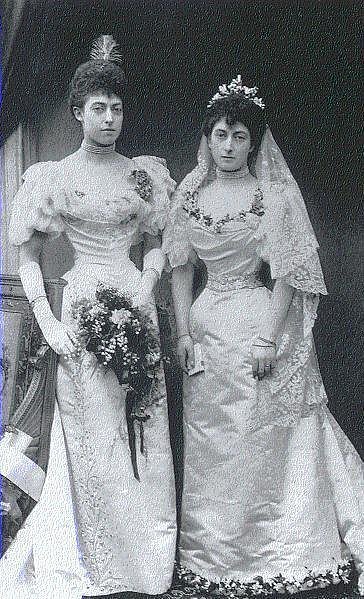 A “Trianon” dress, in stripes of pale blue and white, was brocaded with tiny rosebuds, and made with a white chiffon fichu, edged with ochre lace, and drawn into a stomacher strapped with narrow black velvet, and finished with old silver and diamond clasps. The bride’s mother had recently visited Russia, and there purchased some wonderful crystal handles and knobs for parasols and sunshades. One was egg-shaped, encrusted with gems, another was long and covered with gold filigree, and a third was a crutch handle of pink coral, round which were entwined two gold snakes with sapphire eyes. A “Trianon” dress, in stripes of pale blue and white, was brocaded with tiny rosebuds, and made with a white chiffon fichu, edged with ochre lace, and drawn into a stomacher strapped with narrow black velvet, and finished with old silver and diamond clasps. The bride’s mother had recently visited Russia, and there purchased some wonderful crystal handles and knobs for parasols and sunshades. One was egg-shaped, encrusted with gems, another was long and covered with gold filigree, and a third was a crutch handle of pink coral, round which were entwined two gold snakes with sapphire eyes.Her wedding gown was designed by Miss Rosalie Whyte, of the Royal Female School of Art in Queen’s Square, and was very simple; but, as Miss Whyte said to an interviewer, “the Royal Family have always appreciated the beauty of simplicity in dress.” The white satin for it was woven in Spitalfields, and, in addition to the orange-blossoms worn by all brides, and the German myrtle always liked by the Queen’s family, there was a mixture of white jessamine in the garniture. Personally, Princess Maud does not care for lace, but the Princess of Wales ordered some very fine Honiton point and handkerchiefs for her. Lovely Irish poplins, Derwent dress linens from the Cockermouth Mills, the Bradford manufactures, and the Cheviotside tweeds and coatings from Alnwick, were all included. The tailor-built gowns and some useful mantles came from Redfern’s; and Messrs. Scott Adie had many orders, among them being a deep, wide, circular Alaska sealskin cape, lined with old rose broche’, and having a rich silvery chinchilla collar. Princess Maud has a small, pretty foot, and knows it, so all her boots and shoes had pointed toes, narrow “waists,” and high heels. Busuine was responsible for her riding-habits, and Godfrey & Dart for her cycling costumes. A very special present from the Princess of Wales to her youngest daughter was a magnificent circular cape of royal blue velvet, lined, bordered, and with a big collar of the finest Russian sable. This was supplied by Poland & Son, of Oxford Street. 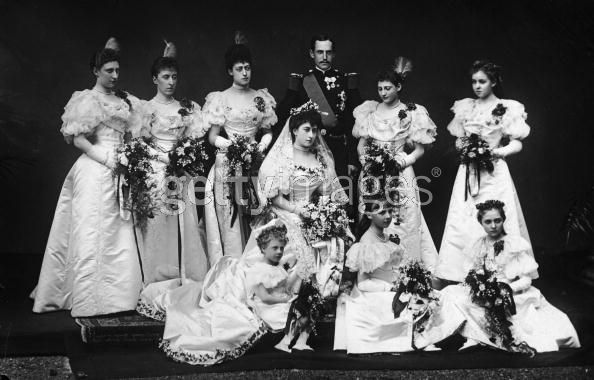 Princess Maud was just a little indifferent about her going-away dress, and the story goes that the Princess of Wales was not altogether pleased with her final choice, so she ordered a delicate rose and apricot shot glace’ silk, with a plain skirt and full ruche of Valenciennes at the hem, an embroidered and jetted Figaro jacket with full vest of pinkish mauve chiffon, a waistband of black and rose satin, fastening under rosettes, Valenciennes ruffles at the wrists, and a small cape to match. It was kept a secret from the bride till almost the last, and then she was obliged to acknowledge her mother’s perfect taste, and declared it was the prettiest dress she had. The wedding day: The West End was profusely decorated with flags, flowers, etc., and there was a conspicuous blending of the British and Danish flags. The Life Guards and the Cold Stream Guards lined the route from Marlborough House to Buckingham Palace, and crowds of people, mostly ladies, were gathered in the vicinity of the Palace, awaiting the arrival of the procession. A cavalcade of heralds and equerries escorted the bridegroom, who was accompanied by his parents, the Crown Prince of Denmark, and Crown Princess Louise, and his brothers, Christian and Harald. The Prince and Princess of Wales and all of the Queen’s children, with their families, were in carriages, except Princess Beatrice of Battenberg and her children, who were absent, on account of their mourning for the death of Prince Henry of Battenberg. The Queen passed quietly into the chapel from Buckingham Palace. The ceremony took place at 12:30 o’clock. The weather was sunny and pleasant. Princes Christian and Harald supported Prince Charles, and the bridesmaids were Princess Victoria of Wales, sister of the bride, and Princesses Ingeborg and Thyra of Denmark, sisters of the bridegroom; Princess Victoria of Schleswig-Holstein, Princesses Patricia and Margaret of Connaught , Princess Alice of Albany, Lady Alexandra Duff, daughter of the Duke of Fife, and Princess Louise of Wales. Princess Maud was given away by her father. [The New York Times: July 23, 1896] |
Princess Victoria, known as Queen Mary through out her reign, was the daughter of Prince Francis, Duke of Teck, the son of Duke Alexander of Württemberg by his morganatic wife, Countess Claudine Rhédey von Kis-Rhéde. Her mother was Princess Mary Adelaide of Cambridge, the third child and younger daughter of Prince Adolphus, Duke of Cambridge, and Princess Augusta of Hesse-Cassel. Through her maternal grandfather she was a great-granddaughter of King George III of Great Britain. By her maternal grandmother she was a great-great-granddaughter of Princess Mary of Great Britain, daughter of King George II of Great Britain. The wedding of Prince George, Duke of York (King George V from 1910–1936) and Princess May took place on 6 July 1893 at the Chapel Royal, St. James's Palace, in London. In 1891, the bride's mother, the Duchess of Teck, had declared that the wedding dress and that of the bridesmaids would be manufactured entirely in Britain, likely because of the fact that she had become president of the Ladies' National Silk Association and evidently had encouraged her daughter to wear silk of English origin. Upon the announcement of Princess May’s marriage to the Duke’s brother, George, Duke of York, Arthur Silver of the Silver Studio, who had originally designed the dress for Princess May’s cancelled wedding to the late Duke of Clarence, was approached once again. His 1892 ‘Lily of the Valley’ dress design for the princesses marriage to the Duke of Clarence had been made public just days before his death and had to be completely abandoned. This time they settled on one of Silver's designs, ‘The May Silks’; the dress would be made to feature the emblems of a rose, shamrock and thistle with Orange may blossoms and true lovers knots. Silver, renowned for his Art Nouveau designs, was also said to be much influenced by Japanese art in his designing. In March 1893, the Duchess and Princess visited the Warner & Sons’ factory at Hollybush Gardens in Spitalfields, London and commissioned them to make the finest white silk with silver-thread by Albert Parchment in time for the July wedding. The dress itself was put together by Linton and Curtis of Albemarle Street. The front of the dress was made of white satin, featuring three small flounces old Honiton lace which had been used on the wedding dress of her mother. The bodice, cut at the throat, was long and pointed and was made of Silver's white and silver brocade, also featuring a small amount of her mother's Honiton lace near the top and on the upper part of the sleeve. The rich satin manteau de cour fell from her shoulders. The train was long and plain (although The Times reported there was none) and the veil of her mother's, which was small and hung down the back of her neck. Her mother's veil was also made of Honiton lace with which Mary fastened by diamond pins given as a gift from Queen Victoria. Matching the orange blossom elements to the dress, small wreaths were placed all the way around the bust and on the hair. Princess Mary completed the wedding outfit with a diamond tiara from Queen Victoria (which can be seen in the above picture); diamond rivière necklace from the Prince and Princess of Wales and diamond earrings and anchor brooch (seen below), a wedding gift from Prince George. Out of all of the wedding toilette, the veil was reportedly the only piece that was not to be worn again after the wedding. 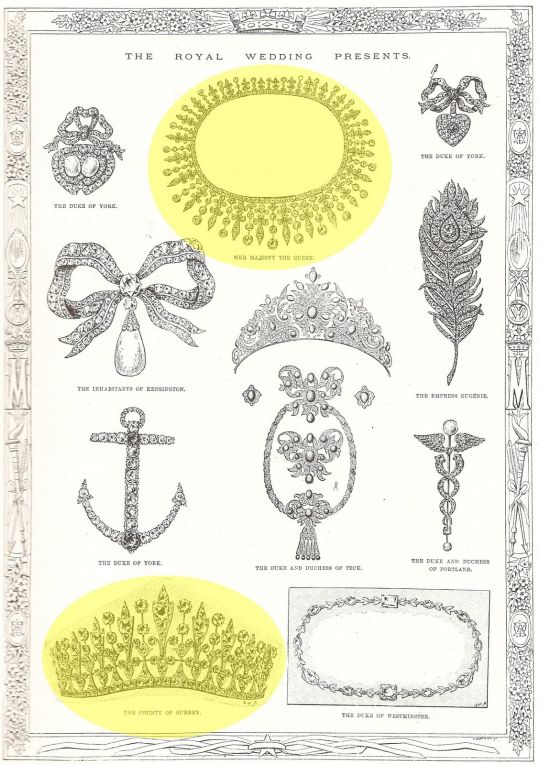 Her trousseau consisted partly of "forty outdoor suits, fifteen ball-dresses, five tea-gowns, a vast number of bonnets, shoes, and gloves," as reported by the Lady's Pictorial. The couple received equally lavish wedding presents, such as jewelry and plates valued at £300,000. Her trousseau consisted partly of "forty outdoor suits, fifteen ball-dresses, five tea-gowns, a vast number of bonnets, shoes, and gloves," as reported by the Lady's Pictorial. The couple received equally lavish wedding presents, such as jewelry and plates valued at £300,000.To the right are a few pieces Mary received as her wedding presents; highlighted are the two fringe tiara's she received: The diamond feather brooch from Empress Eugenie; A brooch with two hearts in diamond setting, a bow-brooch with a hanging diamond-heart and a very large diamond anchor brooch, from the Duke of York; A diamond fringe necklace from Queen Victoria. A large bow brooch with a pear-shaped large pearl from the inhabitants of Kensington; A winged brooch (caduceus) with pearls and diamonds; From the Duke of Portland a diamond fringe tiara from the county of Surrey; A diamond necklace from the Duke of Westminster; and the turquoise suite from her parents the Duke and Duchess of Teck Princess Mary was attended by ten bridesmaids: Princesses Victoria Melita, Alexandra, and Beatrice of Edinburgh (George's first cousins); Princesses Maud and Victoria of Wales (George's sisters); Princesses Margaret and Patricia of Connaught; Princesses Alice and Victoria Eugenie of Battenberg (George's first cousins); and Princess Helena Victoria of Schleswig-Holstein (George's first cousin). 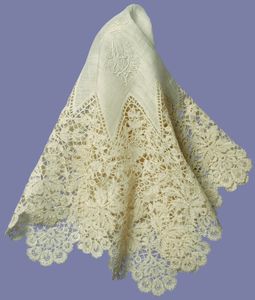 Day of the wedding: Day of the wedding:On the morning of their wedding, George accidentally caught sight of his fiancé down a long corridor of Buckingham Palace; he proceeded to make a "low and courtly bow," a gesture Mary never forgot. The royal parties were brought in large carriage processions, consisting of open landaus. Mary entered in the final procession with her father the Duke of Teck and her eldest brother Prince Adolphus of Teck. Mary greeted the crowds' applause with her "side-ways smile," and with "a little nervous gesture of her white-gloved right hand". As royal weddings were historically popular spectacles, the wedding attracted large crowds, many of which gathered in the route from Buckingham Palace to St James's Palace to give the couple an "enthusiastic reception". Prince George, Duke of York and Princess Mary of Teck were married at 12:30. The Archbishop of Canterbury performed the ceremony, and was assisted by the Bishop of London, the Bishop of Rochester, and five other prelates. 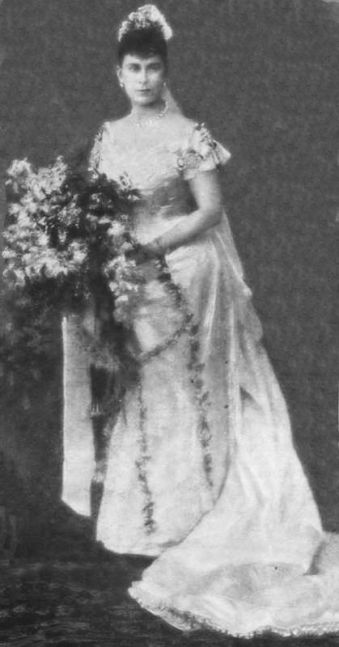 "It is to the strains of the Bridal march from "It is to the strains of the Bridal march from Lohengrin that Princess Mary enters. The observed of all observers in the most literal sense. With downcast eyes and a flush on her cheeks, she looks exquisitely pretty. Her dress of silver and white brocade with its ingeniously clustered shamrocks, roses and thistles is at once simple and elegant. There is no train, or at all events, none that hampers the bride's movement, while a plain court bodice shows off her finely-molded figure to perfection. The bridal veil of fine old Honiton point is caught back off the face, and trails and clusters of orange blossoms, together with the inevitable bouquet of white flowers carried in her hand, complete the salient points of the bride's appearance." Observation of The Times, Saturday, Jul 08, 1893. Upon their marriage, Mary became styled as Her Royal Highness The Duchess of York. They spent their honeymoon at Sandringham, the Prince of Wales' estate in Norfolk. 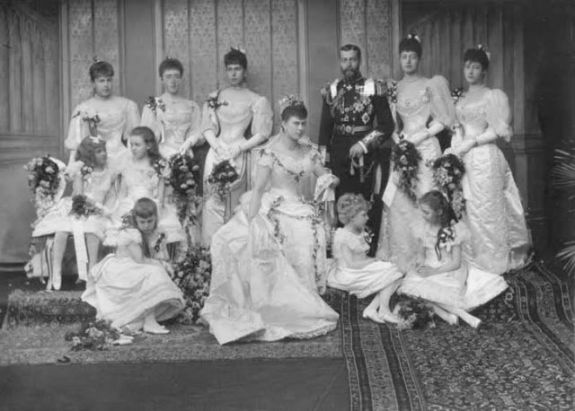 The immediate family present included: HM the Queen, the current Prince and Princess of Wales and family, the family of the Duke and Duchess of Teck, Duke and Duchess of Edinburgh, Duke and Duchess of Argyll, family of Prince and Princess Christian of Schleswig-Holstein, the Connaughts, the Battenberg's, the Duke of Cambridge, and the Grand Duke and Duchess of Mecklenburg-Sterlitz. Nicholas II of Russia, their Majesty's of Denmark, Prince Albert of Denmark and others were also present. |
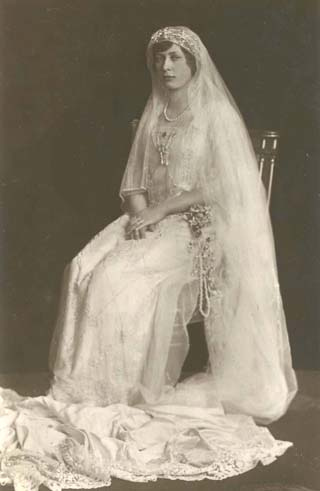 Princess Mary, Princess Royal of the United Kingdom Princess Mary, Princess Royal of the United KingdomCountess of Harewood (25 April 1897 – 28 March 1965) On 28 February 1922, Princess Mary, daughter of King George V and Mary of Teck, married Henry Charles George, Viscount Lascelles, the elder son of Henry Lascelles, 5th Earl of Harewood, and Lady Florence Bridgeman. Their wedding at Westminster Abbey was the first royal occasion in which Lady Elizabeth Bowes-Lyon (later Queen Elizabeth, the Queen Mum), a friend of Princess Mary's and one of the bridesmaids, participated. The Princess was 24, Lord Lascelles was 39. In the early twenties, the style of all dresses, not just wedding gowns was changing. Dresses were soft and relaxed, but were still mid-calf length for most women. The lace wedding dress of Princess Mary follows the straight lines of the day. Her attendants all wear cloche veils as headdresses. Princess Mary’s Gown To Be Cloth Of Silver Her Wedding Dress To Have A Train Of Ivory Silk Woven By Hand The New York Times January 17, 1922 The dress will have a train of ivory silk, shot with silver, which is being woven by hand workers at Baintree, Essex, an old English silk manufacturing center, where the art of silk weaving has been passed down from generation to generation.So great is the care taken in the manufacture of this material that only a few inches are finished each day. The train is expected to be ready soon, and it will then be placed in the hands of the embroiderers." The Princess Royal's engagement ring was emerald: It was described in The Times 25 November 1921 as "a beautiful, single-stone square-cut emerald". In the 1970 Christie's sale of the Princess Royal's jewels, a ring fitting this description was sold for £9000 to Middlemas. "A fine rectangular emerald mounted as a single-stone ring, with diamond five-stone shoulders to the plain hoop." Sources: The Times, 25 November 1921; Christie's. Catalogue of Highly Important Jewels. October 7, 1970. Princess Mary wore the diamond negligé which was the gift of her bridegroom. In the wedding picture it is visible suspended from a very fine chain. It was described as "a diamond and pearl brooch, composed of cushion-shaped and drop-shaped diamond collets mounted in a pierced diamond panel of kite-shaped design supporting in the centre a pear-shaped diamond drop and on each side a diamond riband of different lengths a pear-shaped pearl" in the Christie's 1970 auction catalogue. "It is officially announced that Princess Mary’s bridesmaids will be Princess Maud, youngest daughter of the Princess Royal, Lady Rachel Cavendish, fourth daughter of the Duke and Duchess of Devonshire; Lady Mary Thynne, youngest daughter of the Marquess of Bath; Lady Victoria Mary Cambridge, eldest daughter of the Marquess of Cambridge; Lady Doris Gordon-Lennox, younger daughter of the Earl of March; Lady Elizabeth Bowes-Lyon, youngest daughter of the Earl of Strathmore; Lady Diana Bridgeman, eldest daughter of the Earl of Bradford, and Lady May Cambridge, only daughter of the Earl of Athlone." [Source: New York Times, 1922] The wedding presents: 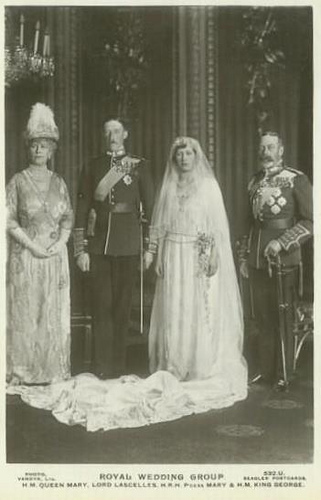 Viscount Lascelles presented his royal bride with an Imperial jewel. The sapphire cluster devant de corsage with diamond swags and loops had formerly been the property of Grand Duke Mikhail Mikhailovich, who had inherited it from his mother Grand Duchess Olga Feodorovna , née a Grand Duchess of Baden. Viscount Lascelles presented his royal bride with an Imperial jewel. The sapphire cluster devant de corsage with diamond swags and loops had formerly been the property of Grand Duke Mikhail Mikhailovich, who had inherited it from his mother Grand Duchess Olga Feodorovna , née a Grand Duchess of Baden.Gifts from her parents included the sapphire and diamond tiara Prince Albert designed for Queen Victoria in 1842; it was part of the sapphire parure Mary received as a wedding present. Queen Alexandra and Queen Mary didn't use the sapphire coronet so it was passed to Princess Mary and her descendants. The groom's parents, the Earl and Countess of Harewood presented the Princess with a magnificent antique diamond brooch. Queen Alexandra presented Mary with a six row emerald bead and pearl necklace, much like the one Alexandra received, inscribed "With every good wish for my darling granddaughter Mary's future happiness with her beloved husband. From her loving old granny Alex". Several wedding presents were of emeralds and diamonds. The most significant of these was the diamond and emerald tiara given by 50,000 V.A.D.s' of the Empire. Sources: The Times, 10 January 1922; 13 Jan 1922; Christie's Important Jewels June 29, 1966 A diamond fringe tiara, composed of fifty-one graduated diamond spikes each intersected by a smaller graduated diamond collet spike, mounted on a graduated cushion-cut diamond collet single-line base. She received this fringe tiara as a wedding gift from Lord and Lady Inchcape. Another wedding gift from Lord and Lady Inchape was a diamond rivière. Sources: The Times 24/25 Feb 1922; Princess Mary's Wedding Number March 4, 1922; Christie's Highly Important Jewels October 7, 1970; Papi & Rhodes Famous Jewelry Collectors. |
Her father was Prince Nicholas of Greece and Denmark, the third son of George I of Greece. Her mother was Grand Duchess Elena Vladimirovna of Russia, a granddaughter of Tsar Alexander II of Russia. On 29 November 1934 she married Prince George, Duke of Kent, son of King George V and Mary of Teck, at Westminster Abbey, London. The wedding of the Duke of Kent and Princess Marina of Greece was the most exciting and and glittering event of the decade. When Princess Marina of Greece became the bride of Prince George, Duke of Kent, in 1934, she introduced a new elegance into the Royal family. Her gown was designed by Molyneux in silver French brocade, made in Lyons, woven with English roses of medieval design, it was the sort of dress an English princess would have worn in the Middle Ages. The material for the dress was so delicate that it was only sent over to England about two weeks before the wedding. The sleeves widened from shoulder to wrist, the cuffs faced with silver brocade. The flowing, billowing white tulle veil was five feet long, widening at the bottom to ten feet. Holding this in place was a magnificent diamond tiara presented to Princess Marina by the Lord Mayor and the citizens of London. She wore two small bunches of orange blossom over each ear. This grand head ornament was worn by the Duchess on many subsequent occasions; she loaned the tiara to her daughter, Princess Alexandra, for her own wedding in 1963. To complete the look she also wore an oblong diamond brooch with square cluster centre and link ends (gift from Queen Mary) and the 36 diamond collet necklace (from George V). Her bridesmaids were her first cousins Princesses Irene, Eugenie and Katherine of Greece and Denmark, her second cousin Grand Duchess Kira Kirillovna of Russia, Crown Princess Juliana of the Netherlands (later Queen Juliana), her husband's niece Princess Elizabeth of York (later Queen Elizabeth II), and her husband's cousins the Lady Iris Mountbatten and the Lady Mary Cambridge. 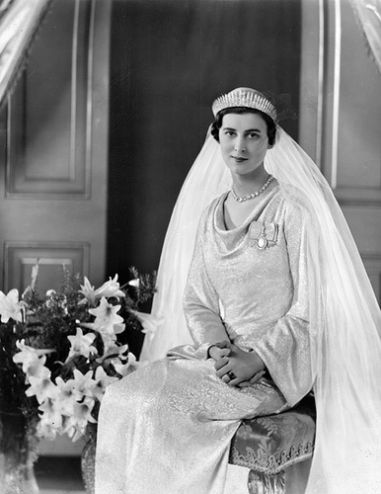 The Duke shared his mother Queen Mary`s passion for fine jewels and patronized jewellers in London and Paris, selecting pieces for his wife with a connoisseur`s eye. His choice of engagement ring - a seven carat emerald-cut sapphire from Kashmir, shouldered by single baguette diamonds an mounted in platinum - like many other pieces reflected his exquisite taste. The Duke shared his mother Queen Mary`s passion for fine jewels and patronized jewellers in London and Paris, selecting pieces for his wife with a connoisseur`s eye. His choice of engagement ring - a seven carat emerald-cut sapphire from Kashmir, shouldered by single baguette diamonds an mounted in platinum - like many other pieces reflected his exquisite taste. The Duke of Kent also chose three eternity rings for Princess Marina. Each ring had different stones with rubies, diamonds and sapphires - the red, white and blue of the national colours. The Times wrote in November 26, 1934 the wedding edition: Eternity rings can be worn with evening dress instead of a wedding ring, the sapphire ring with blue dresses, the ruby with those toning with red and the diamond ring with colours that cannot be matched in precious stones. Eternity rings are also worn instead of the old-fashioned "keeper" rings and are usually an additional gift of the bridegroom on the wedding day, the unbrocken circle of the stones signifying eternity and the permanence of marriage. The Duchess also received several tiaras which consisted of the Cambridge tiara which was owned and worn by Queen Mary. 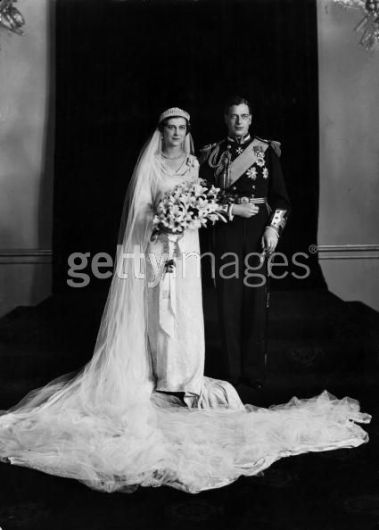 In addition to the tiara, the parure from Queen Mary consists of a pair of sapphire and diamond bracelets, the long sapphire & diamond cluster necklace with the detachable pendant drop, three sapphire & diamond brooches and a pair of cluster and drop earrings. In addition to the tiara, the parure from Queen Mary consists of a pair of sapphire and diamond bracelets, the long sapphire & diamond cluster necklace with the detachable pendant drop, three sapphire & diamond brooches and a pair of cluster and drop earrings.From her mother, Princess Helena, former Grand Duchess of Russia, Marina received Diamond girandoles (diamond earrings). The earrings were rumored to have belonged to Helena's mother, the Grand Duchess Vladimir. A video of the wedding can be found here; <a class="external" href="http://www.britishpathe.com/record.php?id=50263" rel="nofollow" target="_blank">The Royal Wedding (aka Duke and Duchess of Kent's Wedding)</a> |
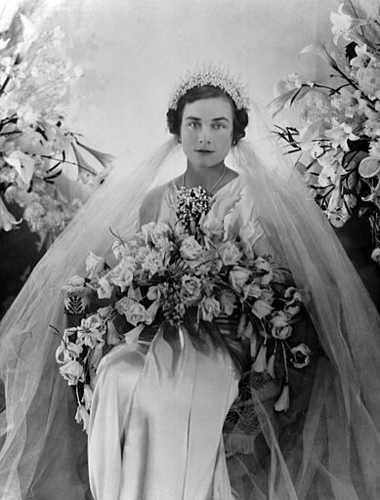 Lady Alice Christabel Montagu-Douglas-Scott Lady Alice Christabel Montagu-Douglas-ScottPrincess Alice, Duchess of Gloucester (25 December 1901 – 29 October 2004) In August 1935, Lady Alice became engaged to Prince Henry, Duke of Gloucester, the third son of King George V and Mary of Teck. They were married in a private ceremony, in the Private Chapel, Buckingham Palace, on 6 November of that year. A much more elaborate wedding was originally planned for Westminster Abbey; but after Lady Alice's father died of cancer on 19 October 1935, and in consideration of the King's own failing health, it was decided that the wedding should be scaled down to a more private setting. Her dress was designed by Norman Hartnell, who also designed the wedding dresses of princesses Elizabeth and Margaret. It was made in a blush/pink-coloured silk crepe. Her bridesmaids were her sister the Lady Angela Scott, her nieces, the Lady Elizabeth Scott, Miss Clare Phipps, Miss Anne Hawkins, her husband's nieces Princesses Elizabeth (future Queen Elizabeth) and Margaret Rose of York, her cousin Miss Moyra Scott and her husband's cousin the Lady Mary Cambridge. 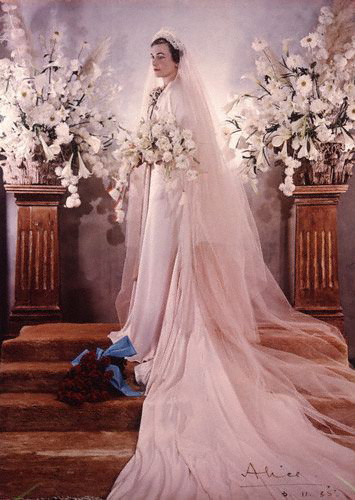 When Lady Alice married Prince Henry, the Duke of Gloucester, she was given also a collection of a seven-piece suite of pearls and diamonds (no tiara in this suite) jewelry by Queen Mary and the King George V. The Gift include: A diamond collect necklace (56 collets or diamonds); A large diamond scroll brooch, detachable cluster centre with 3 drop shaped diamond cluster drops; A five stone diamond ring A fancy pearl & diamond ring; A pair of diamond collet and pearl drop earrings; A large baroque pearl and oval diamond cluster brooch; A diamond ribbon bow top brooch pendant with and diamond and pearl swinging ornament and a diamond and pearl cluster; ornament containing a watch suspended from bow by a double diamond collet chain; Another part was a ten-piece turquoise and diamond parure, which includes the turquoise and diamond scroll tiara. |
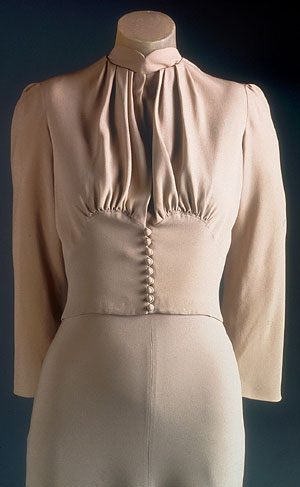 Wallis was the daughter of Teackle Wallis Warfield and Alice Montagu. She married King Edward VIII (then, after the abdication, Duke of Windsor) on 3 June 1937 at the Château de Candé. The date would have been King George V's 72nd birthday; Queen Mary thought the wedding had been scheduled for then as a deliberate slight. No member of the British Royal Family attended. Wallis was the daughter of Teackle Wallis Warfield and Alice Montagu. She married King Edward VIII (then, after the abdication, Duke of Windsor) on 3 June 1937 at the Château de Candé. The date would have been King George V's 72nd birthday; Queen Mary thought the wedding had been scheduled for then as a deliberate slight. No member of the British Royal Family attended.Always correctly dressed, the Duchess of Windsor's wedding ensemble was perfectly appropriate for the occasion. Designed by Mainbocher, it comprised a simple, floor-length dress with a matching long-sleeved jacket. Modest, without being prim or prudish, it was typical of the Duchess of Windsor's fashion austerity. Even the gloves were designed specifically to accommodate the wedding ring. Her co-ordinating blue straw hat had a halo effect with pale blue tulle and her matching gloves were created from the same blue silk crepe as her dress. Not everyone, however, appreciated the Duchess's choice of outfit with its subtle nuances. The Duchess's friend Lady Diana Cooper was typically vociferous, "I didn't like the dress, and as for the hat, it was appalling." The silk crepe was originally "Wallis Blue," a color developed by Mainbocher to match the Duchess of Windsor's eyes. Due to a defect in the stability of the dye, the material has uniformly lost its color. The shoes and the coq feathers decorating the hat, however, have retained the original light periwinkle blue. [Source: Copyright © 2000–2011 The Metropolitan Museum of Art] On her wedding day, Wallis, wore the sapphire and diamond bracelet on her right wrist. 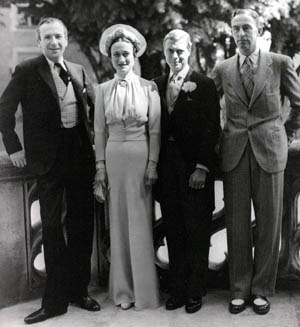 On her left wrist she wore the diamond crosses bracelet. At the throat of her dress she wore an art deco geometric curving double clip with oval sapphires and radiating baguette diamonds made by Van Cleef, one of her favorite designers, in 1936. On her left wrist she wore the diamond crosses bracelet. At the throat of her dress she wore an art deco geometric curving double clip with oval sapphires and radiating baguette diamonds made by Van Cleef, one of her favorite designers, in 1936.The emerald and diamond engagement ring: her ring was re-made by Cartier in Paris in 1958, using the stone from her original engagement ring. The emerald is step-cut with cut corners weighing 19.77 carats; set within a stylised leaf border set with brilliant-cut diamonds inscribed :Monture Cartier; together with the original emerald ring mount by Cartier, London, 1936, inscribed in facsimile in the shank: We are ours now 27 X 36; and signed Cartier, London 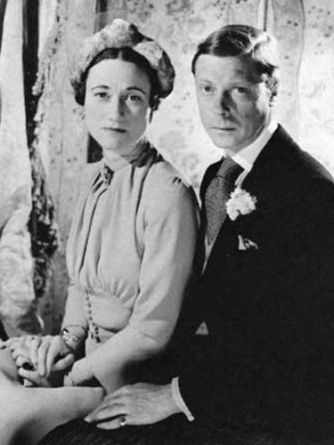 "The Most Copied Dress in Fashion History" On the eve of the Duke and Duchess of Windsor's wedding, Life magazine reported, "Women of the world were little absorbed in the conventional satin gowns of England's new Queen. What Mrs. Wallis Warfield Simpson would wear, however, roused their avid curiosity." Just over a week after the nuptials, copies of the Duchess of Windsor's wedding dress, which reportedly cost $250, were appearing in New York department stores. Bonwit Teller sold a version for $25, Lord & Taylor for $16.95, and Klein's cash-and-carry store for a mere $8.90. Within a few months, copies of the "Wally" dress were being sold in department stores throughout America in a range of different styles, colors and materials. The dress is now on exhibit at the Metropolitan Museum of Art. [Source: Copyright © 2000–2011 The Metropolitan Museum of Art] |
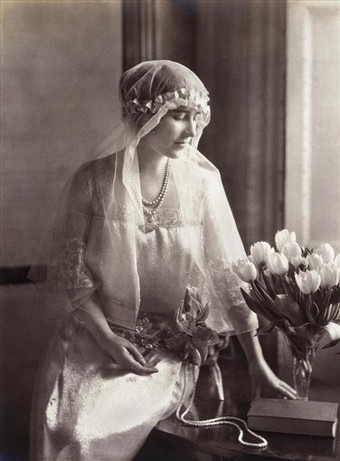 Lady Elizabeth Bowes-Lyon Lady Elizabeth Bowes-LyonQueen consort, Queen Mother (4 August 1900 – 30 March 2002) Lady Elizabeth Bowes-Lyon, the mother of Queen Elizabeth II, wed Prince Albert, Duke of York (later George VI) on 26 April 1923 at Westminster Abbey, London. Elizabeth's wedding dress featured embroidered with pearls and a silver thread, which was made from deep ivory chiffon moire. It was intended to match the traditional Flanders lace provided for the train by Queen Mary. Elizabeth's dress, which was in the fashion of the early 1920s, was designed by Madame Handley Seymour, who had been a dressmaker to the dowager Queen Mary. A strip of Brussels lace, inserted in the dress, was a Strathmore family heirloom. A female ancestor of the bride wore it a grand ball for "Bonnie Prince Charlie", Charles Edward Stuart. The silver leaf girdle had a trail of spring green tulle, trailing to the ground; silver and rose thistle fastened it. According to an era news article: "In the trimming the bride has defied all old superstitions about the unluckiness of green." Unlike more recent dresses, details of this one were publicly revealed in advance of the wedding day. However, the dress was worked on until the last possible opportunity: the day before the wedding, Elizabeth divided her time between the wedding rehearsal and her dressmakers. 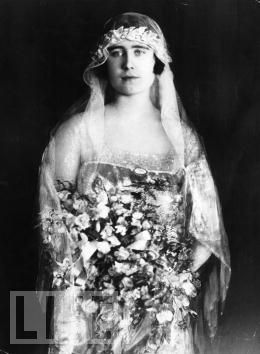 Lady Elizabeth was attended by eight bridesmaids: The Lady Mary Cambridge, daughter of the Marquess and Marchioness of Cambridge, great-niece of Queen Mary and thus a cousin of the groom; The Lady May Cambridge, daughter of Princess Alice and the Earl of Athlone, niece of Queen Mary and thus first cousin of the groom; The Lady Mary Thynn, daughter of the Marquess and Marchioness of Bath; The Lady Katharine Hamilton, daughter of the Duke and Duchess of Abercorn; The Hon Diamond Hardinge, daughter of Lord and Lady Hardinge; The Hon Cecilia Bowes-Lyon, daughter of Lord and Lady Glamis, niece of the bride; The Hon Elizabeth Elphinstone, daughter of Lord and Lady Elphinstone, niece of the bride; and Miss Betty Cator (later sister-in-law to the bride, as Hon Mrs Michael Bowes-Lyon). Lady Elizabeth was attended by eight bridesmaids: The Lady Mary Cambridge, daughter of the Marquess and Marchioness of Cambridge, great-niece of Queen Mary and thus a cousin of the groom; The Lady May Cambridge, daughter of Princess Alice and the Earl of Athlone, niece of Queen Mary and thus first cousin of the groom; The Lady Mary Thynn, daughter of the Marquess and Marchioness of Bath; The Lady Katharine Hamilton, daughter of the Duke and Duchess of Abercorn; The Hon Diamond Hardinge, daughter of Lord and Lady Hardinge; The Hon Cecilia Bowes-Lyon, daughter of Lord and Lady Glamis, niece of the bride; The Hon Elizabeth Elphinstone, daughter of Lord and Lady Elphinstone, niece of the bride; and Miss Betty Cator (later sister-in-law to the bride, as Hon Mrs Michael Bowes-Lyon). |
